Ep. 83: AKIRA Volume 4, by Katsuhiro Otomo
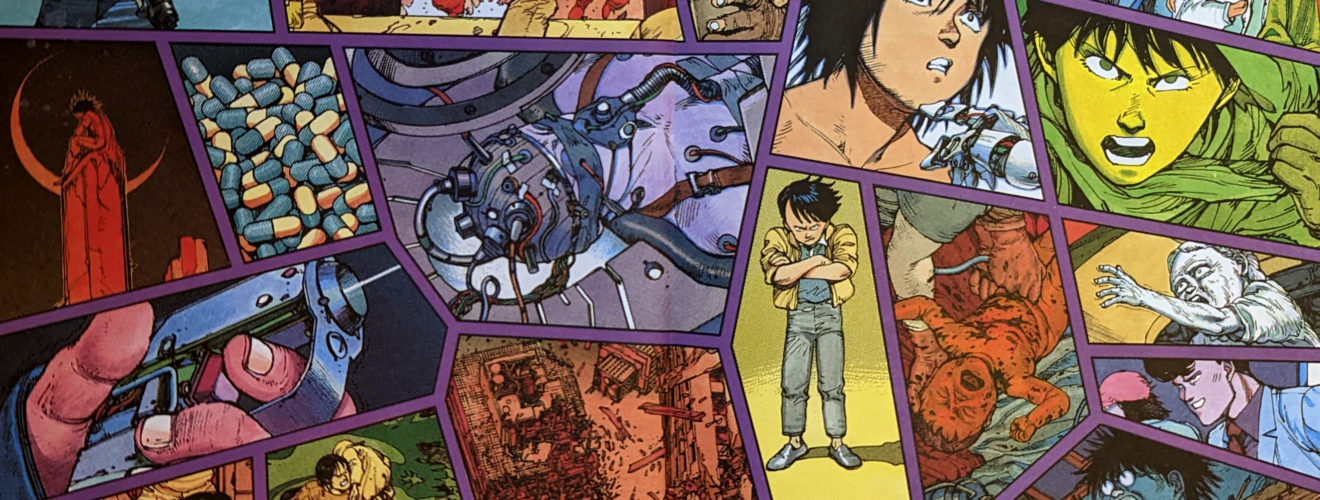
This week the Mangasplainers wrap up the third season of the podcast with their continuing look at Katsuhiro Otomo’s legendary manga series AKIRA with volume 4. This volume diverges dramatically from the events of the movie, and is something of a shocker for fans who’ve only seen that. Will THIS be the volume of the legendary manga series that causes the Mangasplainers to fall out of love with the title? Obviously not, no, but it’s still a really fun discussion. Plus Q&A is back!
Powered by RedCircle
Listen and Subscribe to the Podcast:
Google | Apple | Stitcher | RedCircle | Amazon | Radio Public | PocketCast | Spotify
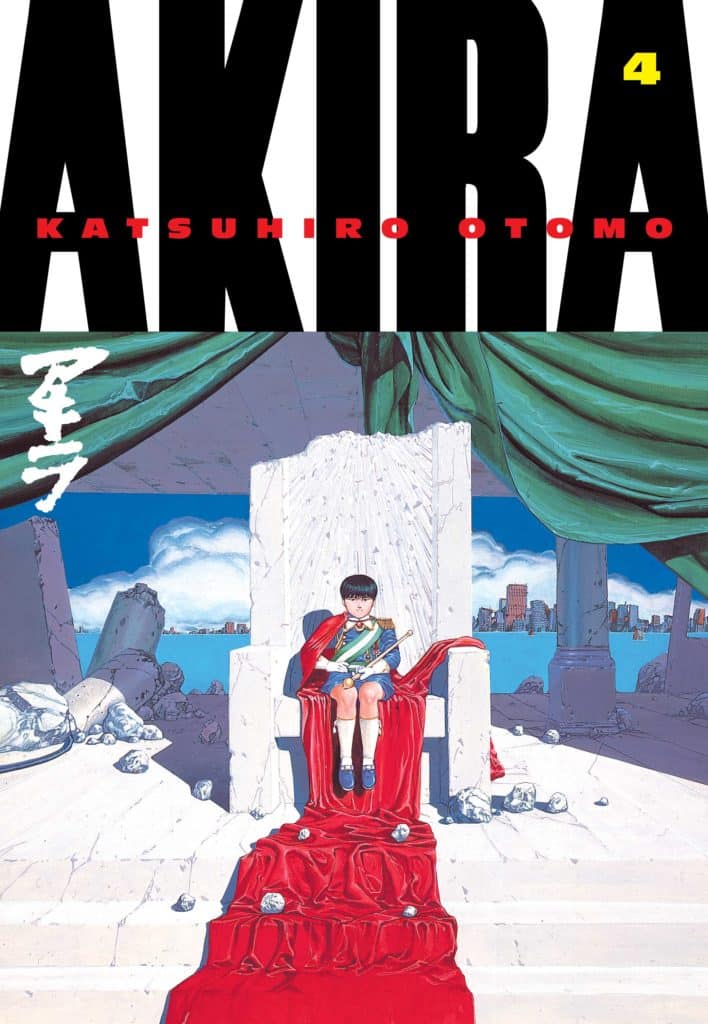
AKIRA Volume 4
By Katsuhiro Otomo
Translation and English Adaptation by Yoko Umezawa, Linda M. York, Jo Duffy, and Stephen Paul
Lettering for the Kodansha edition by Evan Hayden
Edited by Ajani Oloye
Published in print by Kodansha
Audio editing by David Brothers. Show notes by Christopher Woodrow-Butcher and Deb Aoki
BEFORE WE GET STARTED: Hi Christopher here! Thanks to David for jumping in to host this one! I was not very awake when this episode started, and David knocked it out of the park. I get going about half-way through.
Also, a content warning: There’s some unpleasant stuff this volume around rape, violence, drug use, etc., and we try to handle it as sensitively as we can, but it’s not for everyone.
As mentioned the last times we covered AKIRA (Volume 1, Volume 2, Volume 3), this, alongside Miyazaki’s Nausicaa of the Valley of the Wind, has one of the most complicated and lengthy publishing histories of any English language manga release. There are three main English language-editions: 1) the first English editions published in 1988 featuring colored artwork from Steve Oliff, published by Marvel/Epic (and collected as graphic novels by Graphitti Designs); 2) the first black and white edition, also “flipped” to read in the North American reading order, published by Dark Horse Comics in 2000 (a version of this edition was published by Kodansha as well); and 3) the most recent edition, the first ‘unflipped’ (Japanese reading order) edition in black and white and with a new translation, published by Kodansha exclusively as part of the AKIRA 35th Anniversary Edition Box Set in 2017.
We talk about all of these volumes more-or-less interchangeably, and also reference the AKIRA animated film (1986) quite a bit as well, as many events from the manga play out in the film slightly differently.
In short, you can follow this episode reasonably well without having listened to our previous episodes on AKIRA or having read the work, but it would be easier if you had. 🙂
Finally, as mentioned there’s no digital edition of AKIRA, so all of the example images (republished here under fair use) are photographed, rather than screenshot or scanned, so they’re a little janky at times. Apologies in advance.
03:30 Deb’s right, this is where the book really, really diverges from the events of the ground-breaking, genre-defining film. If you’ve only seen the movie and think you know the story of AKIRA, you really, really don’t.
06:37 After the chaotic and over-the-top energy of volume 3, Kaneda’s volume-long absence changes the tone pretty dramatically. It’s very much a breather after the break-neck pace of volume 3, and really the first three volumes together. It’s also very dark. Things have really fallen apart in Neo-Tokyo, and overall social collapse that includes the underlying threat of rape for some of the more vulnerable survivors.
08:45 Christopher references Carla Speed McNeil’s Finder, a far future science-fiction story about a world that’s rebuilding after tremendous loss. It’s set in the far future, and so some of the things that the current society doesn’t know how to do like repair or rebuild the giant dome that protects their cities from solar radiation, for example, but some things have endured, like styles of music that we love today. It’s a really interesting SF series, and it’s collected in a couple of big Library editions from Dark Horse. A recommended read if you’ve been enjoying AKIRA so far!
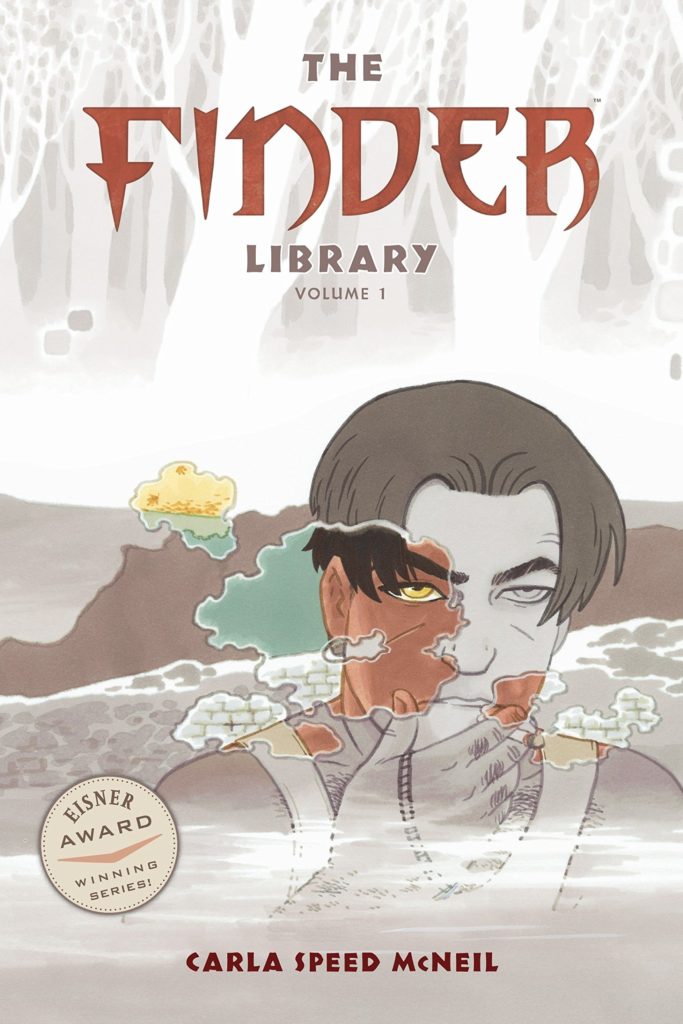
10:05 Yeah, there were more than a few moments when I kind of realized that the aimless young men being taken in by Tetsuo’s army might have been kind of… sad losers before the cataclysm? Otaku stereotypes abound in the bad guys in volume 4.
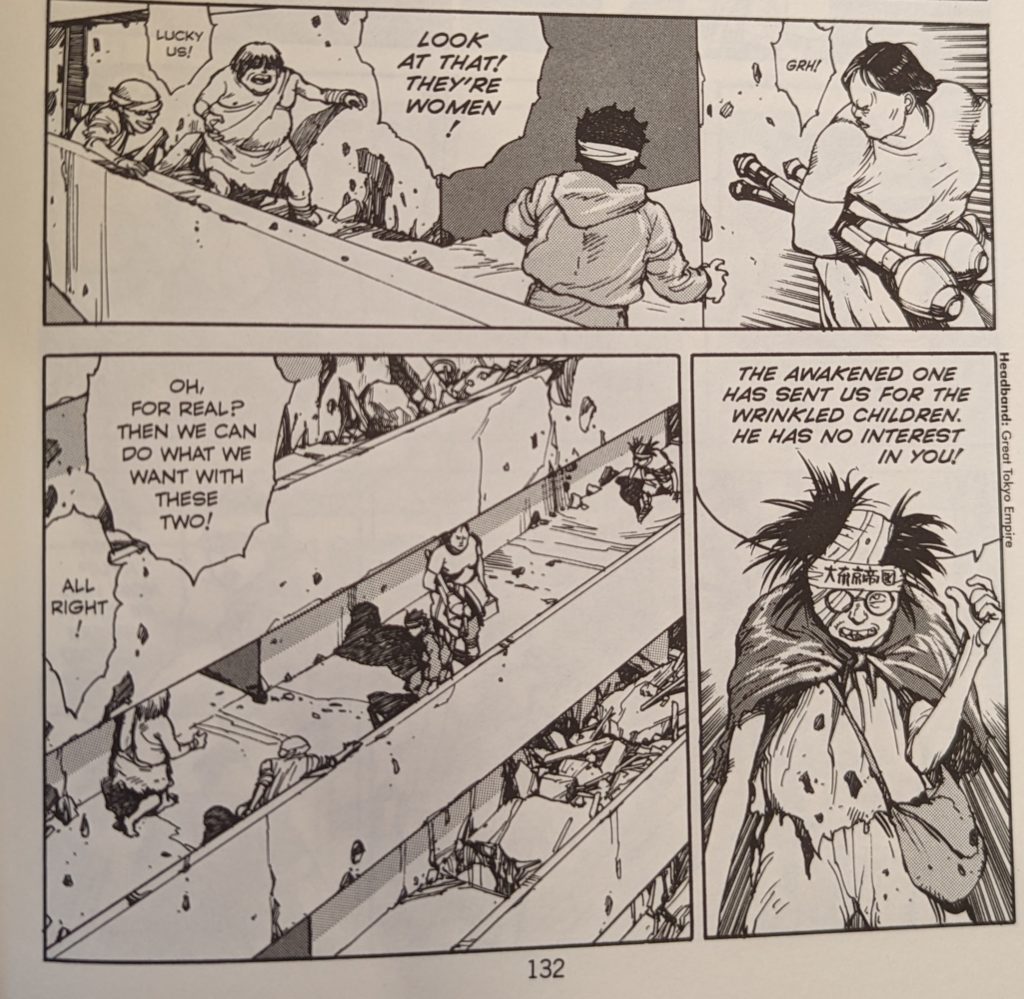
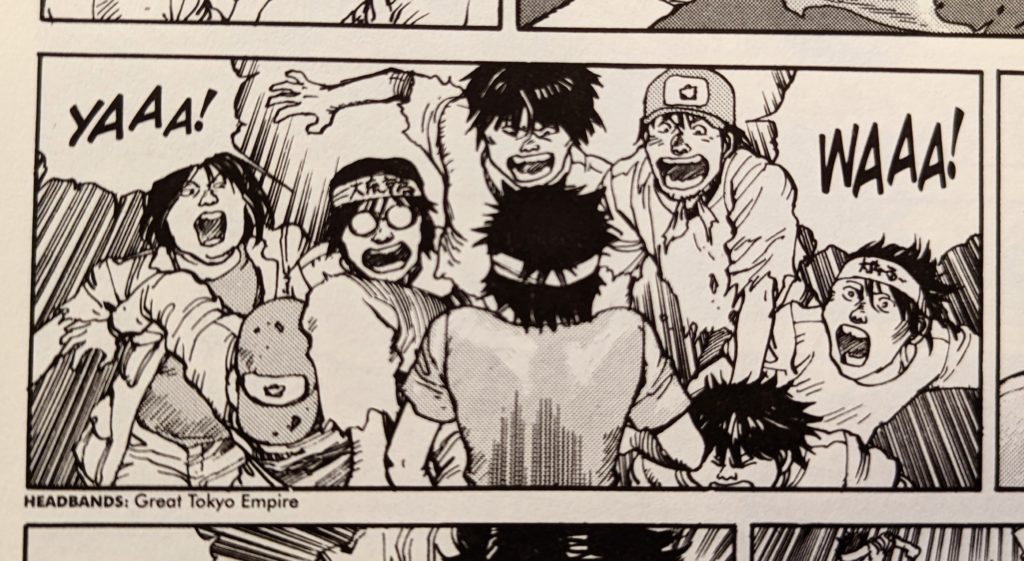
10:35 As technology fades (or is stripped for parts) in the Great Tokyo Empire, having a crazy, blind psychic guy standing on top of concrete pillars acting as a loudspeaker is kind of an amazing idea.
DEB: The blind person who can “see” with otherworldly powers is a motif I’ve seen in other manga – most recently in One Piece, during the Wano arc.
CHRISTOPHER: AKIRA is very influential!
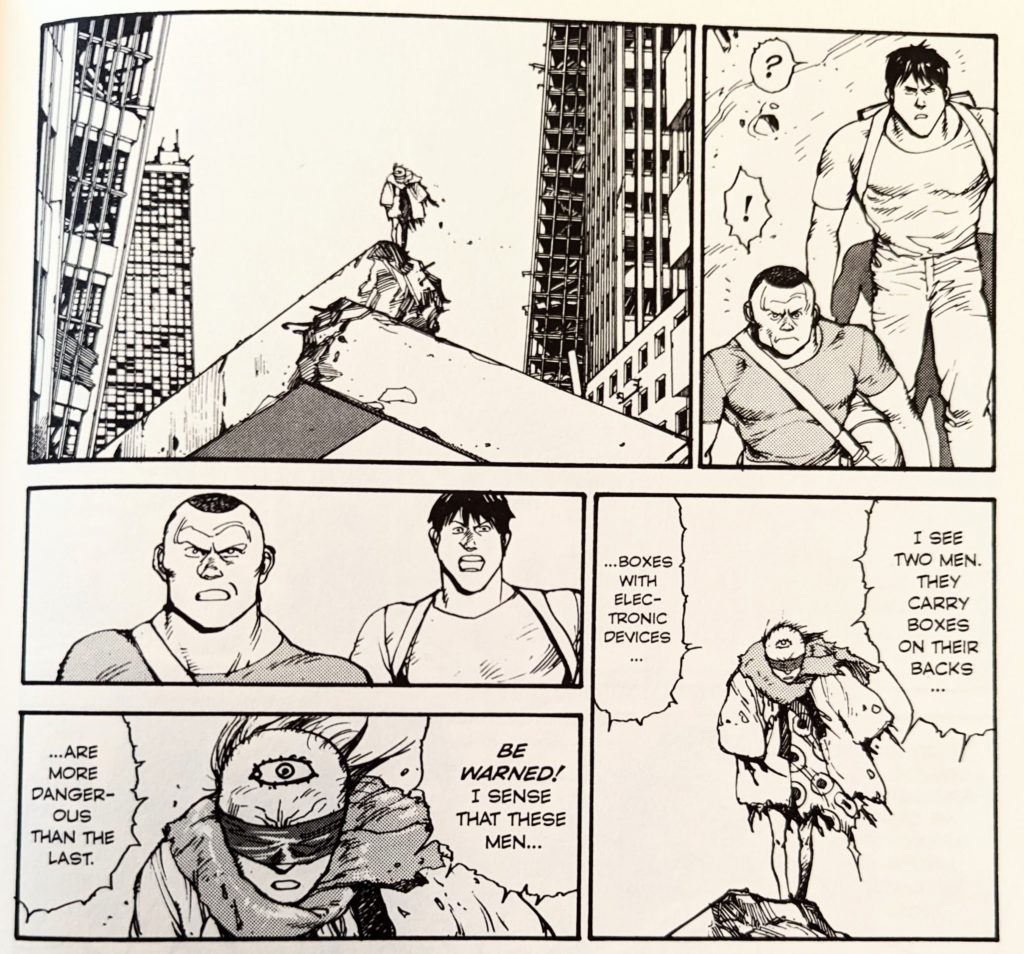
12:20 The art is just utterly perfect. Check out page 218 with Tetsuo’s fist. Hands are really hard to draw, but you wouldn’t know that if you only read Otomo’s work.
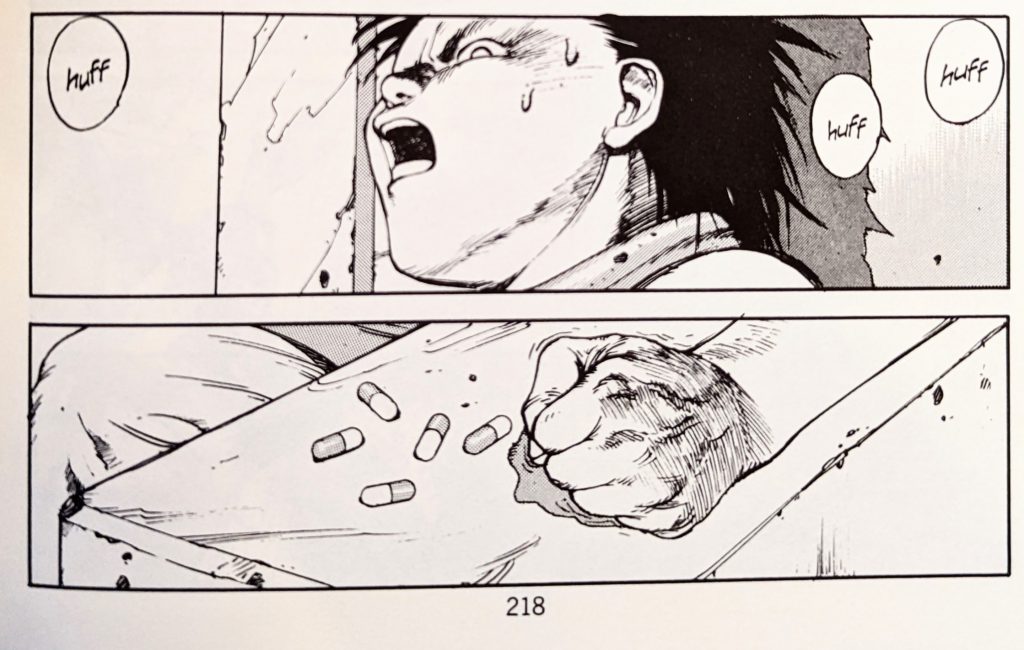
13:18 The Iconic “They’re just like candy!” Pill on the tongue image that launched a thousand rave flyers.
DEB: This image (along with clips from the AKIRA anime) were a familiar sight in 1990s warehouse techno/house rave parties and flyers for events, for kinda obvious reasons…
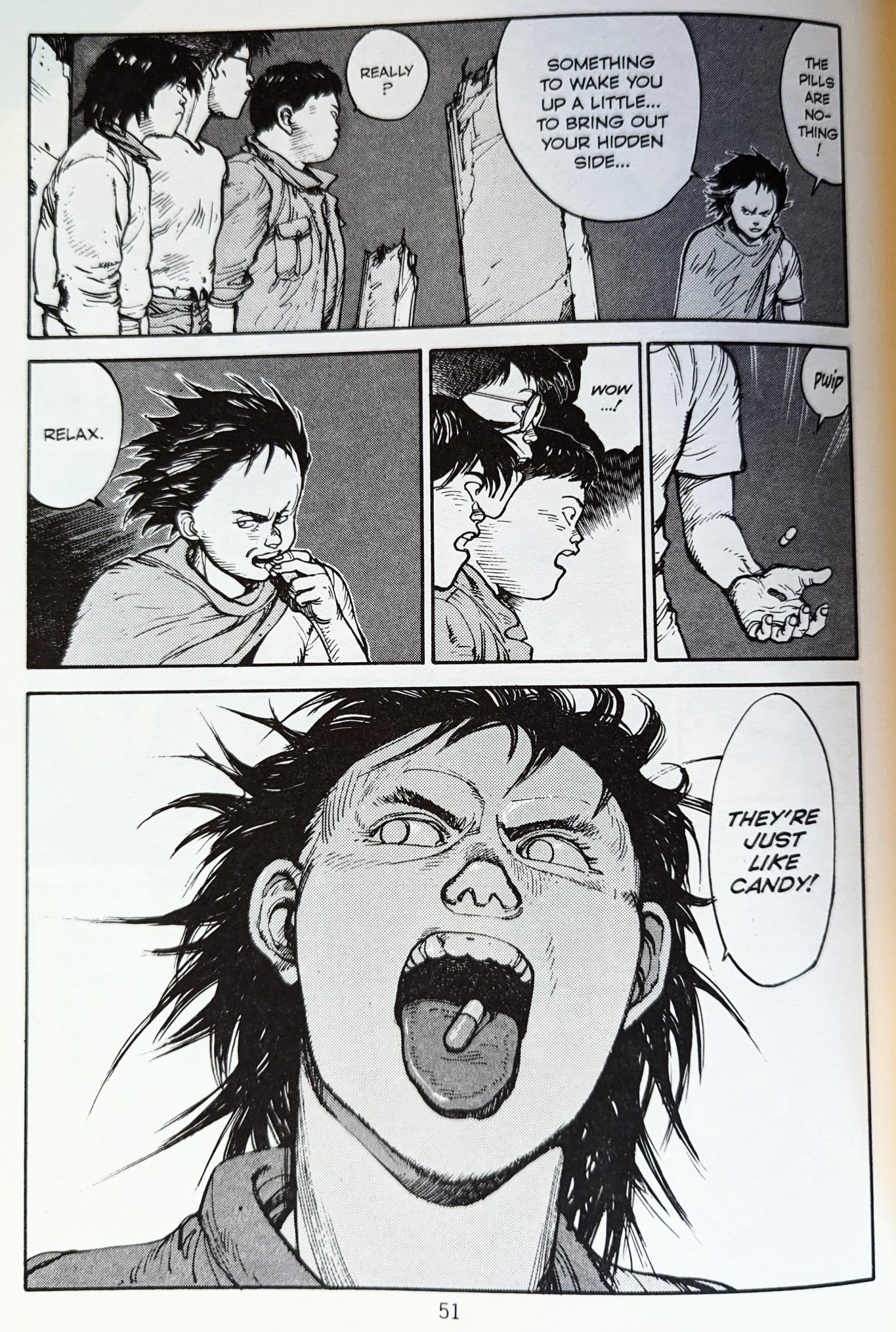
CHRISTOPHER: I also should have mentioned this strung-out Tetsuo double-page spread, I’ve seen this used as well and it really is an outstandingly drawn spread, communicating so much Very Bad Vibes.
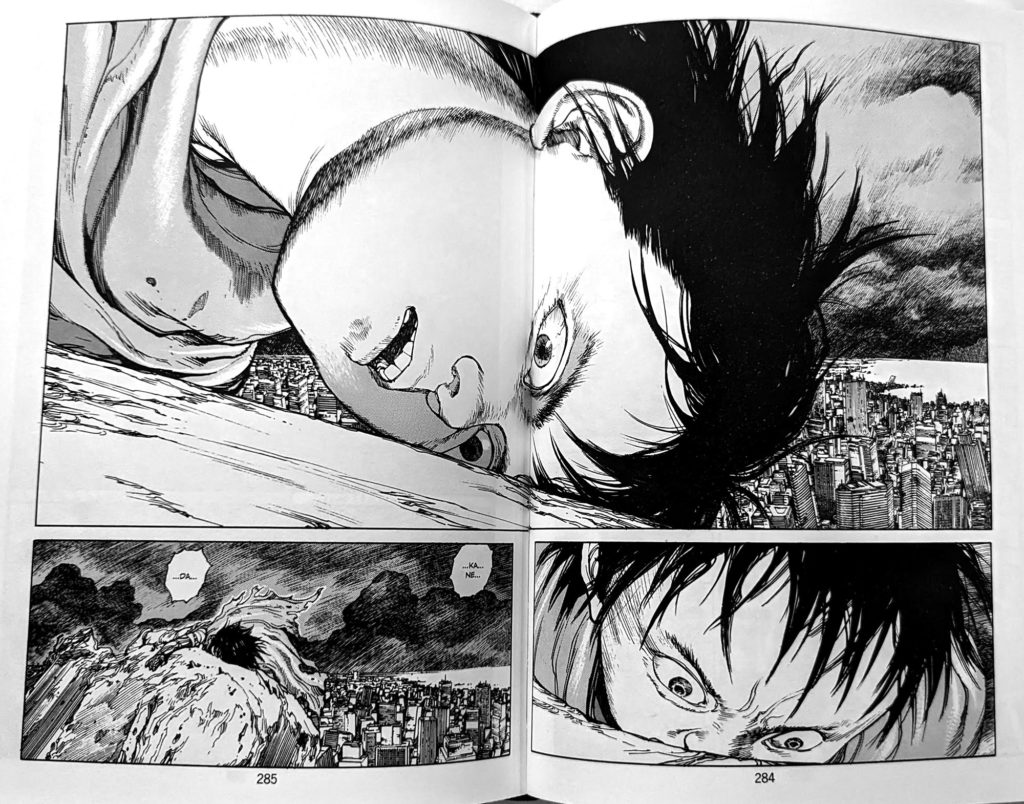
13:29 We mention so many different images here, but the temple going up in flames sequence is shocking.
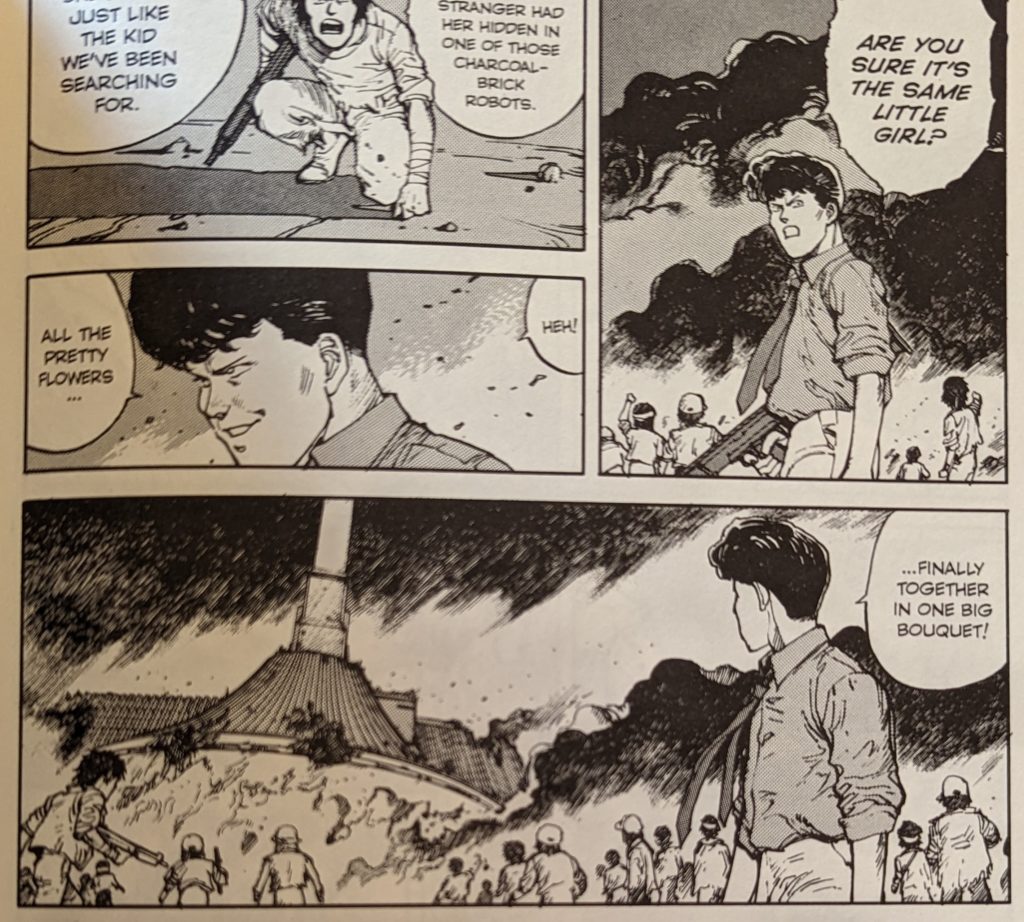
And then the return to the nursery, and seeing it in its now dilapidated state is sobering in contrast to the sterile, modern, and spacious playground that it once was.
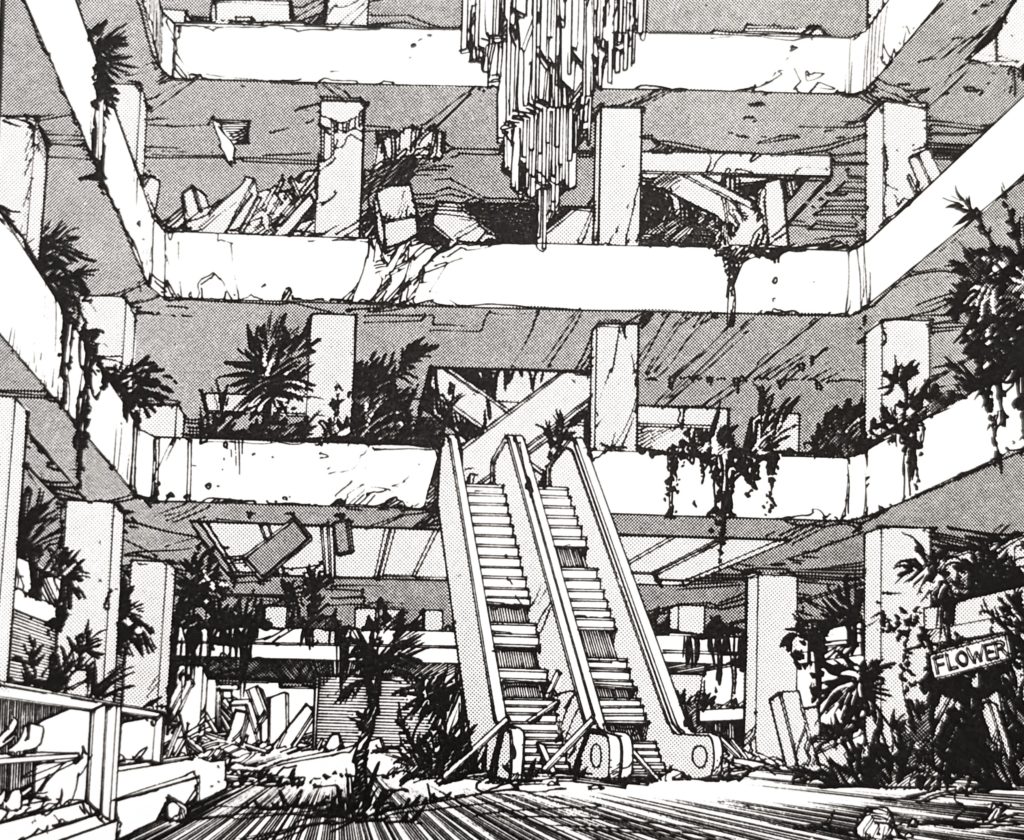
14:54 Yeah, this might be the only visual-gag in the entire volume, the Looney Tunes / coyote gets charred joke..
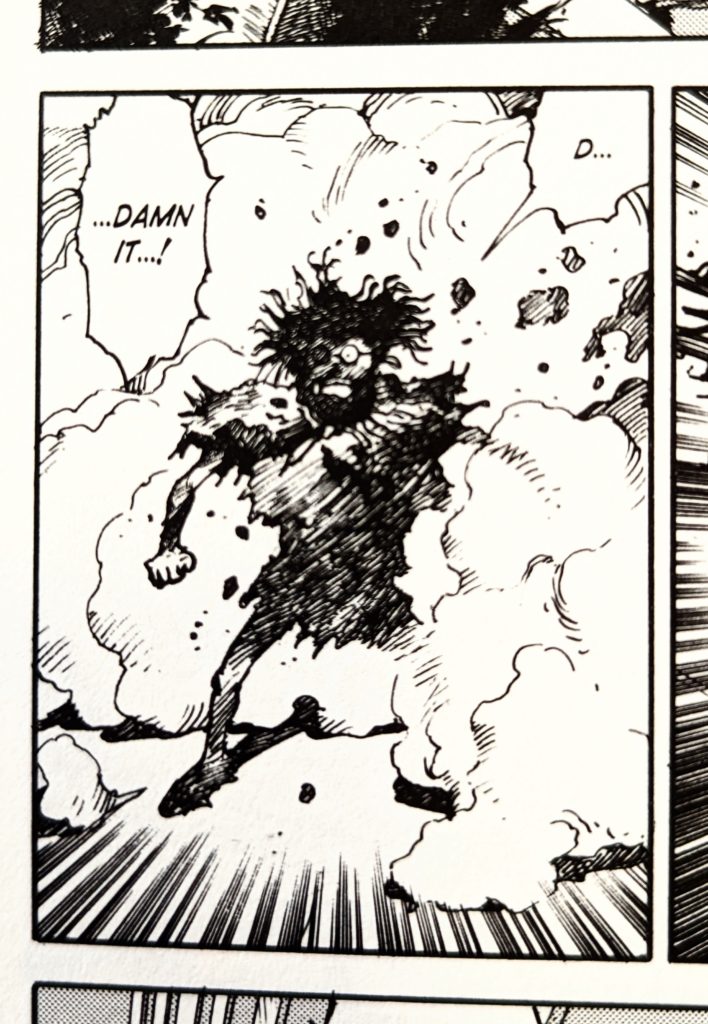
15:15 Which isn’t to say that there aren’t funny moments, exactly, in this book. This sequence with a dude who gets his head caved-in by Chiyoko is shocking and over-the-top. I laughed, but maybe you won’t. Ouch.
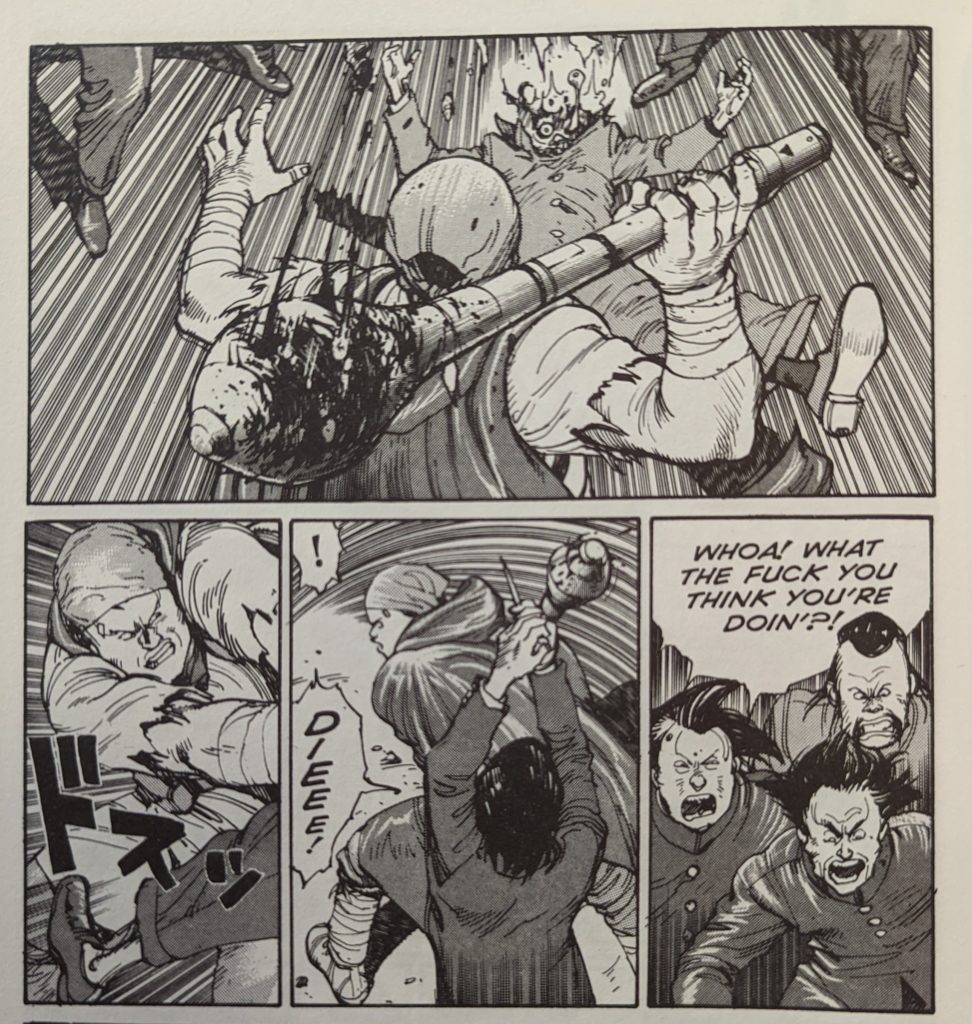
16:47 Christopher talks about the understated scale of the sequence on Page 158, moving the cradle through the ruined city. If you stop and really take it in, it’s incredible.
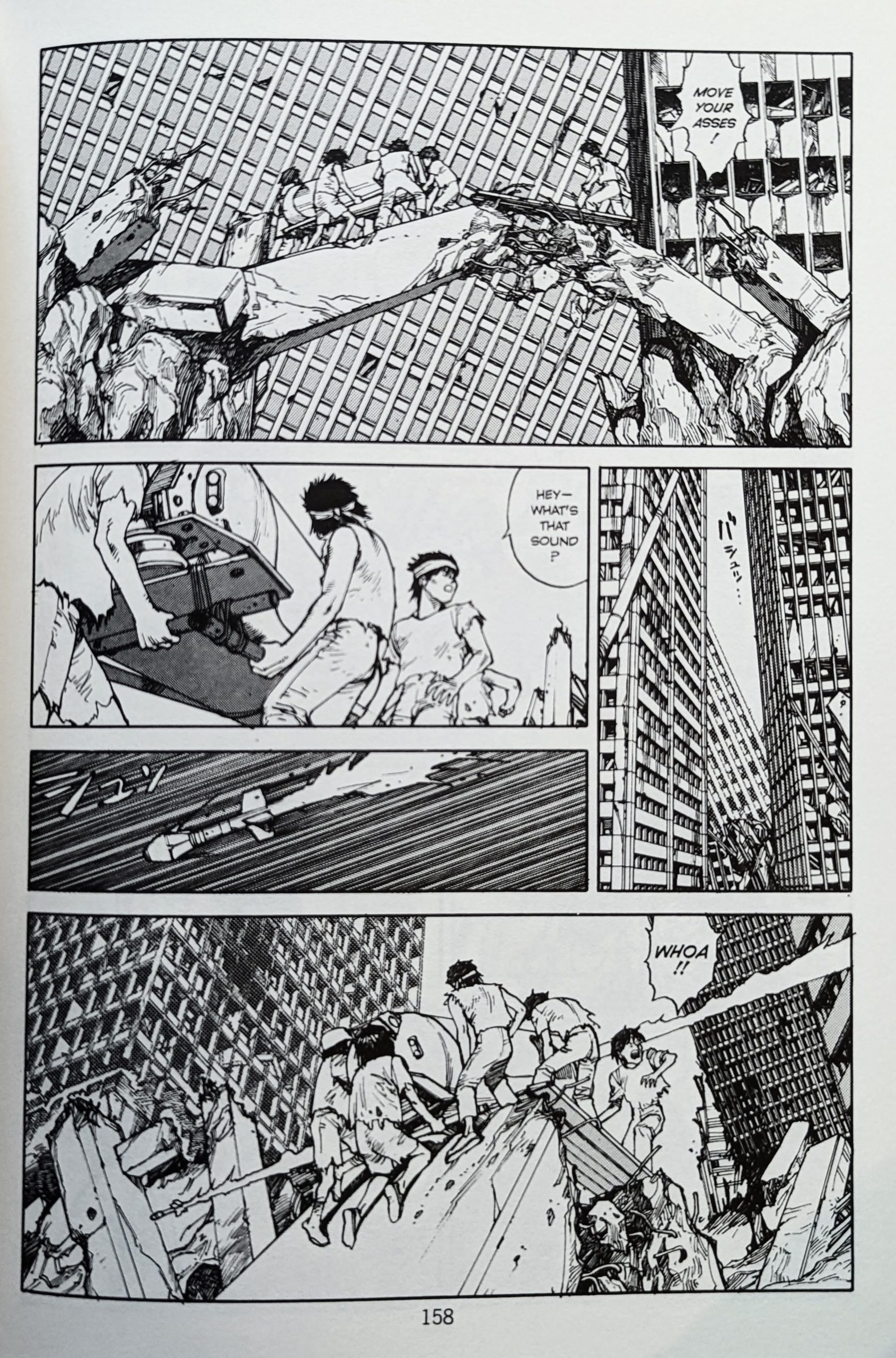
17:49 Chip goes in on the lack of the ‘hero shot’ and the foregrounding of storytelling here… When Chiyoko is finally introduced, she doesn’t get a big entrance, she’s just in a little square panel at the bottom of the page.
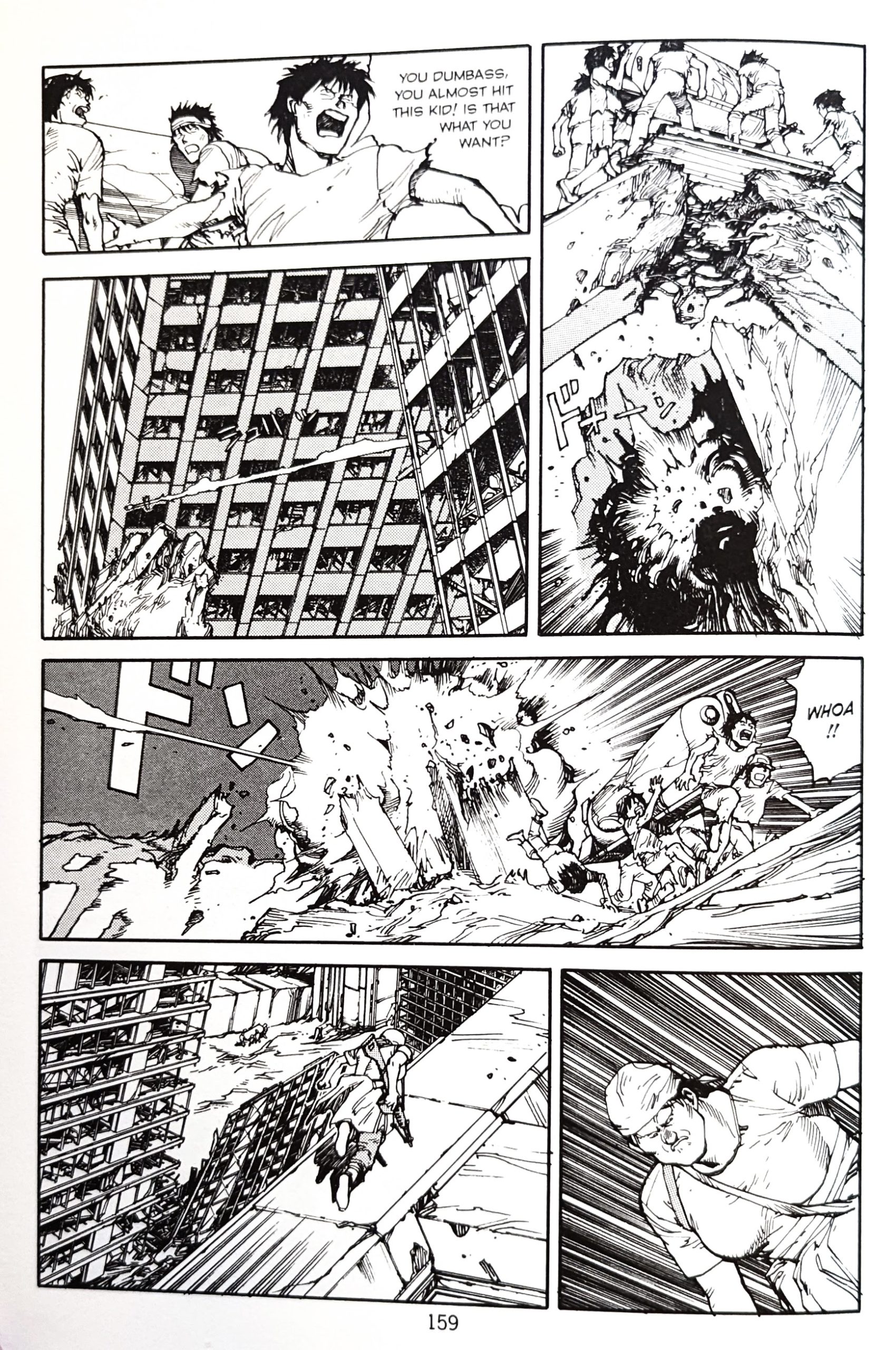
19:13: One of the things that I noticed here is that there are fewer “dutch angles” in this volume. Here’s what we mentioned in the volume 3 notes about “Dutch angles” and their use in AKIRA:
Chip mentions ‘dutch angles’, which is another filmic technique (photography and cinema) where the horizon of a shot is ‘tilted’ so that it doesn’t run parallel to the bottom of the camera frame. This creates a dynamism and makes a sequence feel more energetic, sometimes tense or uneasy or anxious. It’s still used, albeit more sparingly, in more-or-less every superhero movie, among other genres of film. The Batman TV show did, in fact, use it to a near-ludicrous degree.
But if you look at the images on the pages above, the action is all relatively even with the horizon line, while the backgrounds have ‘natural’ diagonals from the debris and collapsed buildings. It’s a pretty great effect!
19:50 David mentions the very deliberate two-panel moment of the spray paint graffiti on Page 11. Setting the scene and the mood, slow start.
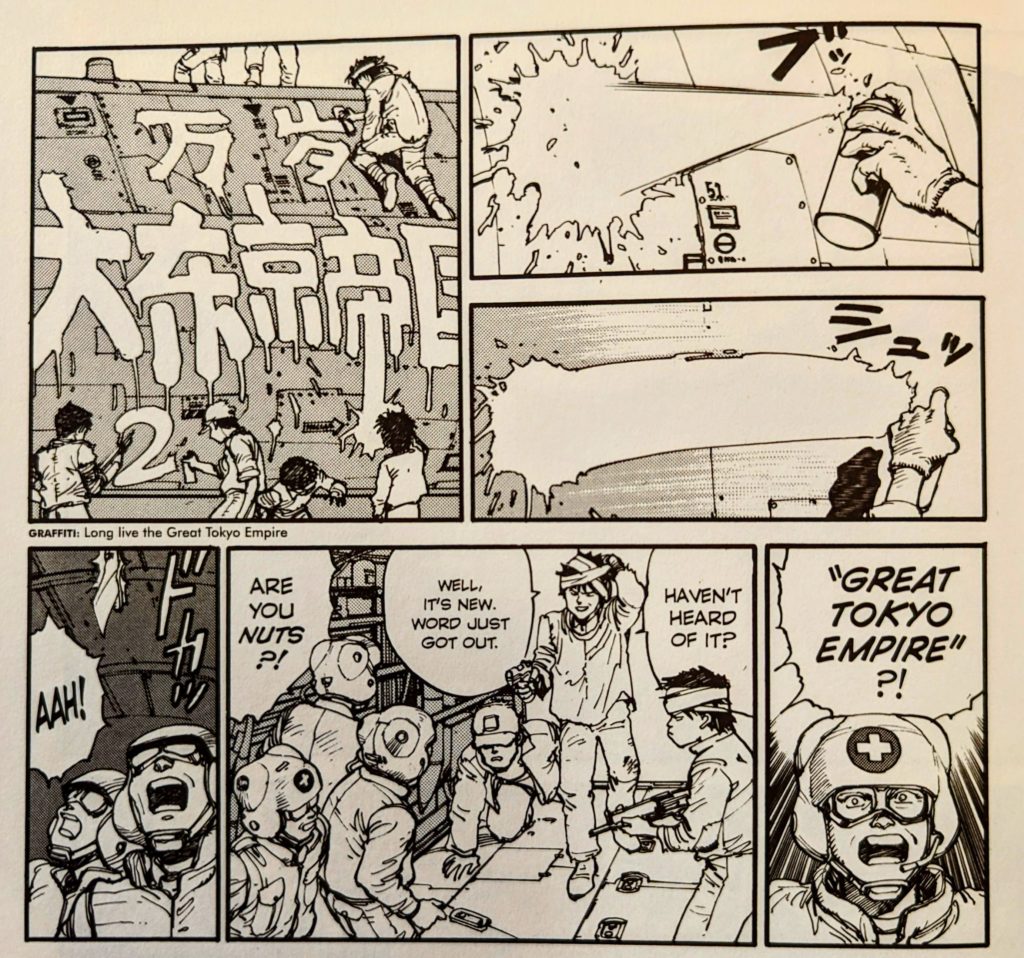
21:15 Speaking of a slow start, the image of the ruined Neo-Tokyo, post-cataclysm, and its oddly calm clouds and water, is so, so strong on Pages 12-13. It’s also interesting that this isn’t a full ‘spread’ necessarily, with a second tier of panels along the bottom, creating an ultra-widescreen panel across the top.
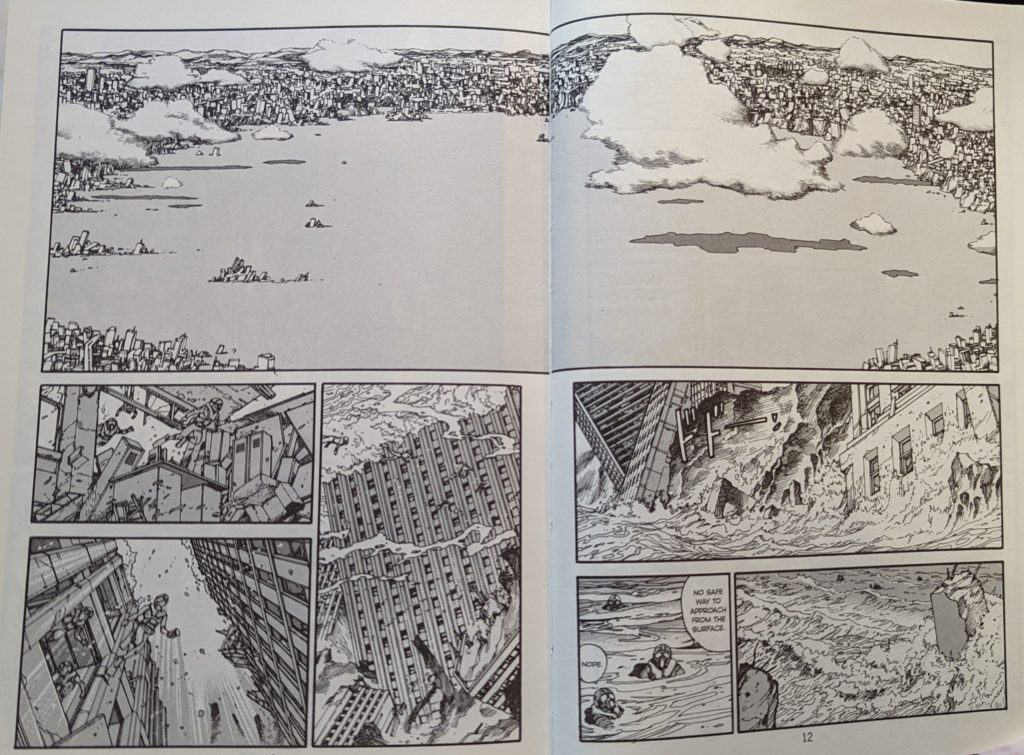
21:45 There’s an interesting ‘zoom’ happening here, where after the very big pages on 12-13, we slowly move into see the military operatives on the page, dwarfed by the destruction around them, until the images shift focus firmly too them. Interesting framing of these scenes.
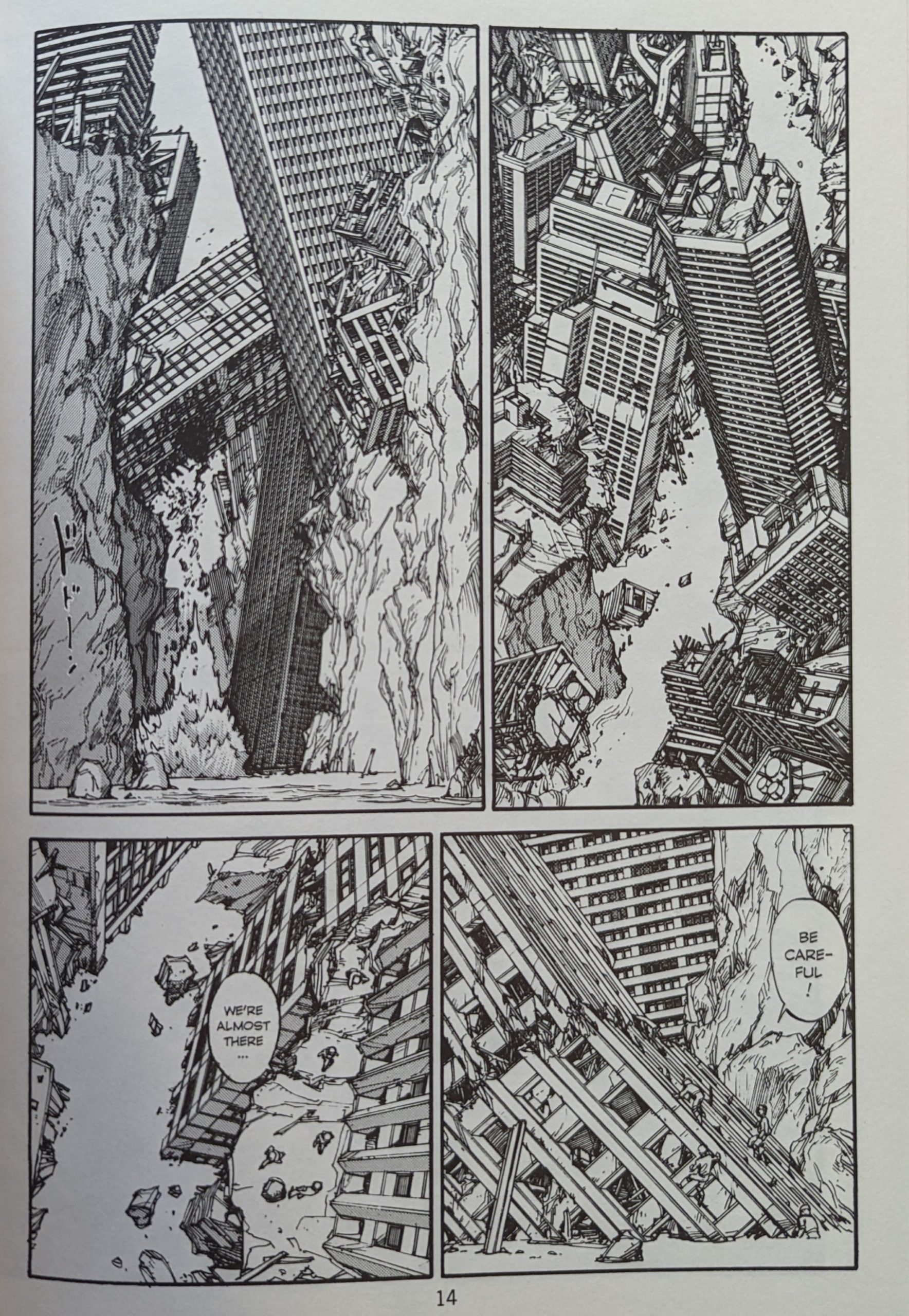
22:43 I mention the “hero shot” again, and it’s of one of Tetsuo’s Army’s psychic goons breaking through a wall. It reminded me a LOT of the introduction of the “Lickers” enemy from Resident Evil 2, and how you get a little hint that something’s about to happen before you get one of the very best jump-scares in video game history. Sadly, couldn’t find the video of the scene I was looking for, but this sequence from the recent remake will help you get the gist of it.
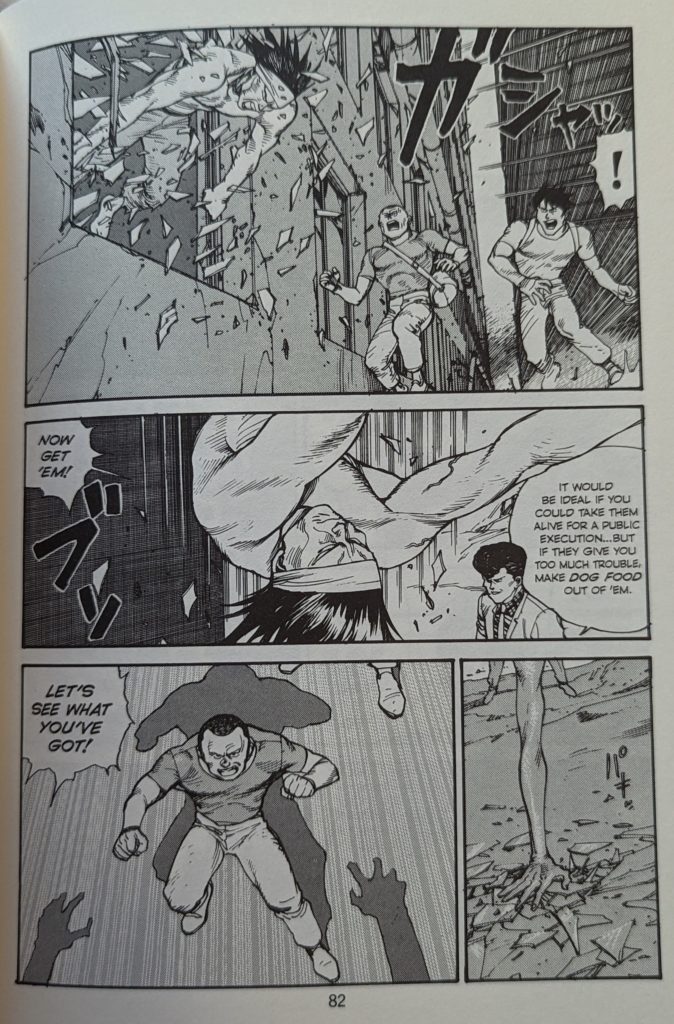
23:50 We mention Chiyoko emptying a full clip into the rapist…
DEB: I gotta say, this scene is mighty satisfying, even though it’s a waste of ammo. 😉
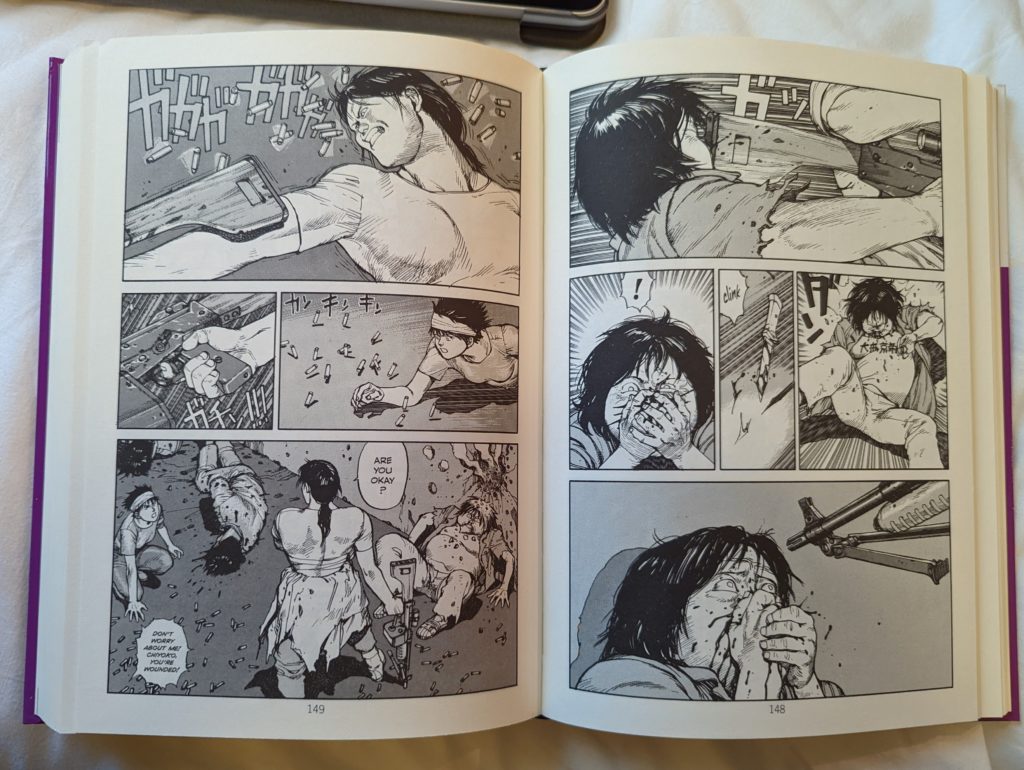
CHRISTOPHER: But Deb got it right on the podcast and I missed it, she empties it… directly over his head? It seems a little strange, given the ultraviolence of the other Chiyoko sequences in this volume that this dude gets off scot-free. But maybe he really was supposed to have been turned to silly putty in this panel and it would’ve been just too violent? I wonder.
DEB: I think Chiyoko being satisfied with just leaving the man in a state of terror instead of killing him makes her heroic and in a way, more bad ass than the awful people she’s up against.
25:15 Chiyoko punching the dude through the lifeboats from volume 3 remains amazing. Why not one more shot of that?
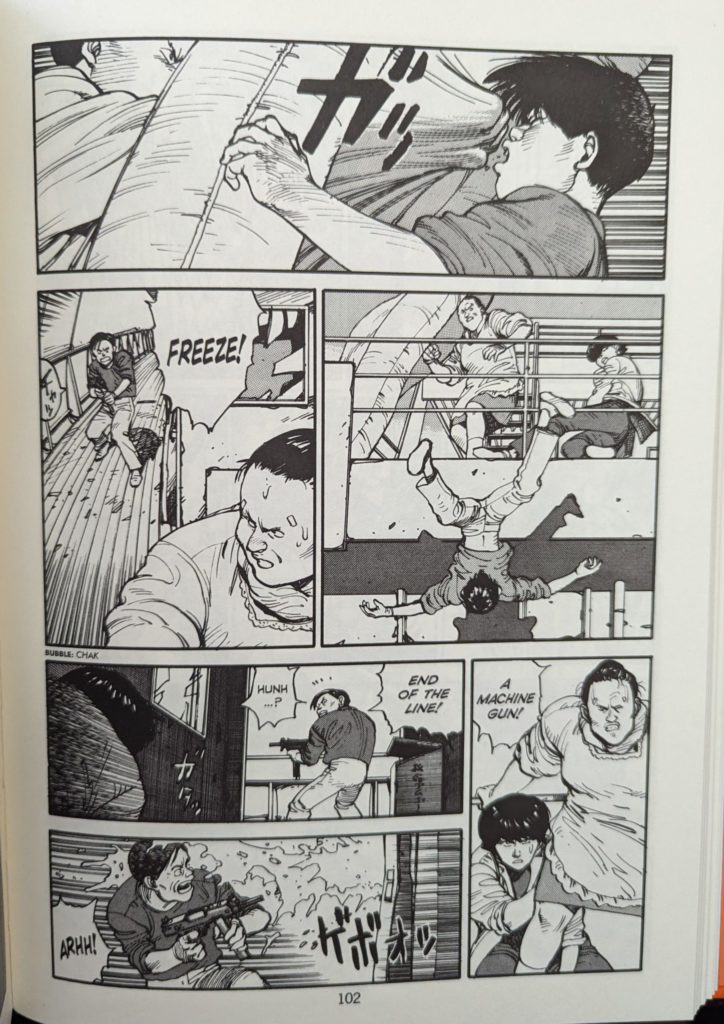
26:20 Legend of Mother Sarah is a post-apocalyptic SF manga written by Katsuhiro Otomo, and illustrated by Takumi Nagayasu (although his work looks a LOT like Otomo’s). It was partially published by Dark Horse, only one tankoubon was released of the seven in the Japanese edition, and that doesn’t even cover all of the single issues that Dark Horse published from this series. And, yes, manga used to be published in single issue comic books. Lol. The one trade paperback/collected graphic novel that Dark Horse published is technically out of print, but it’s very easy to find for cheap, if you’re curious. The series was finished in French, and maybe in Spanish, if you’re particularly good at tracking down out-of-print books in different languages.
INTERESTINGLY, I wonder if the reason why Dark Horse stopped publishing this series (and sales were probably a contributing factor) is because of some sort of very large error that they made during its publication. I remember them printing full page advertisements, apologizing for something to do with the book, not only in their own comics but in like, magazines as well. Maybe Wizard? Except, I literally cannot find any mention of this on the internet, nor a copy of the apology page. It’s very, very strange? Like, so much of the past isn’t recorded online, but I remember seeing this apology page in comics dozens of times, and can’t find it anywhere online now. I don’t even know where to start looking.
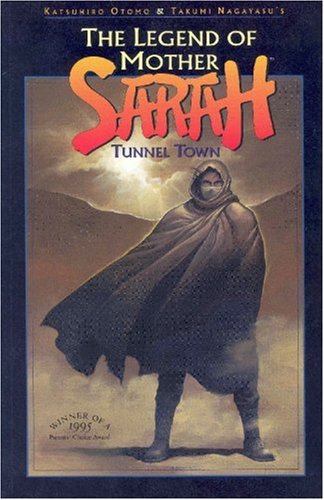
28:15 Having two people closely interact, fighting in water and debris, and then rats coming up out of the water? It’s just a bunch of things that are tough to draw that look effortless on the page.
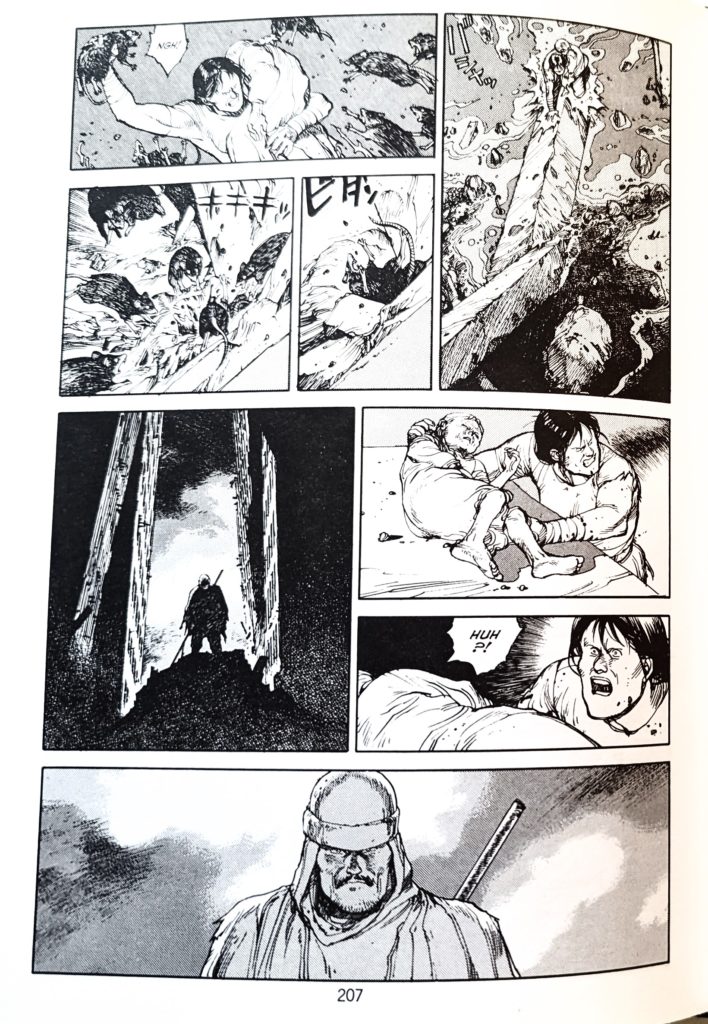
29:45 “This is where my wife died…”
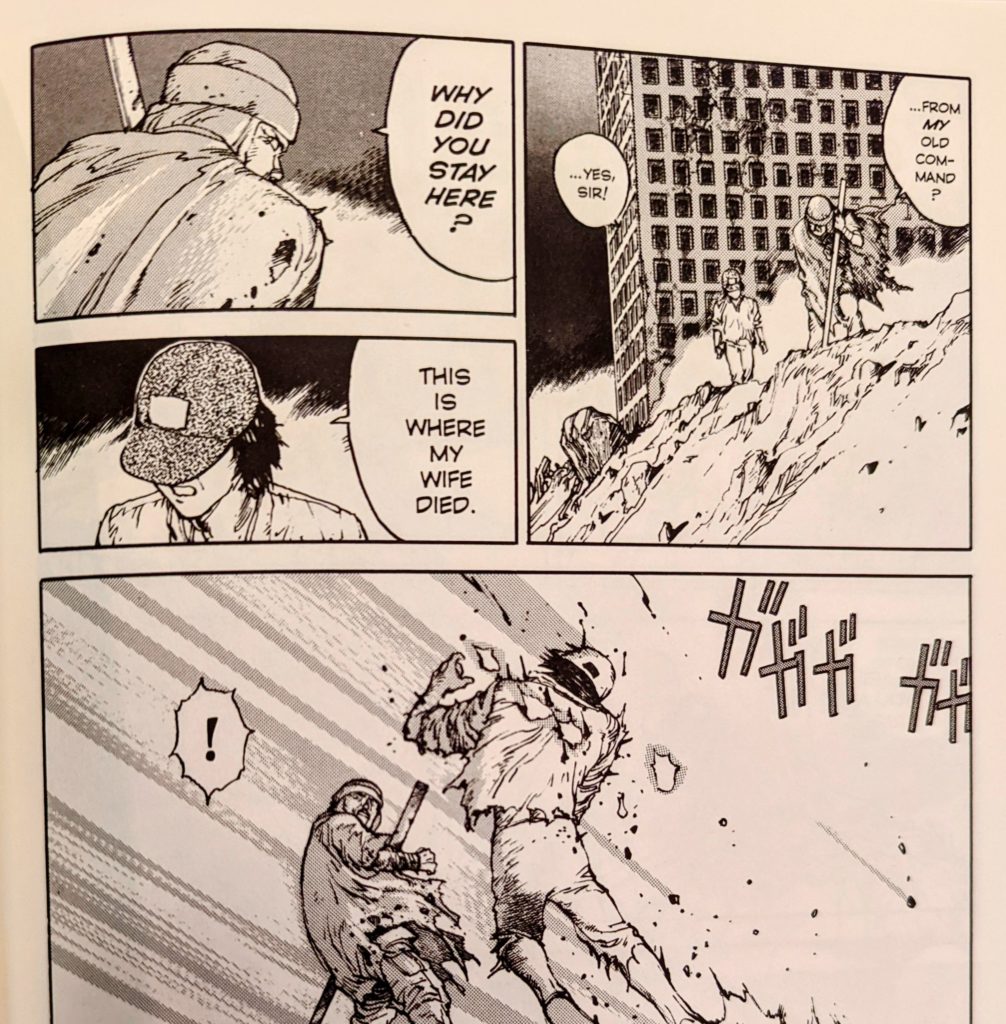
DEB: This is the kind of heart-breaking moment in AKIRA reminded me of real stories of heartbreaking loss of life and families being torn apart from the bombing of Tokyo, Hiroshima and Nagasaki during WWII. (Go read Barefoot Gen and From This Corner of the World or watch Grave of the Fireflies to get some idea of what that felt like, from a Japanese point of view).
Otomo, born in 1954, grew up in the generation that was born after the end of WWII, but was a child in the midst of the rapid industrialization of post-Occupation Japan, and a middle school / high school student when the student protest movement of the late 1960s/early 1970s was in full swing in Japan. So a lot of what you’re seeing in these volumes of AKIRA echo these experiences.
If this kind of thing intrigues you, go pick up Shigeru Mizuki’s dense but informative manga history of modern day Japan, Showa: A History of Japan. Drawn and Quarterly has just released a new 4-volume edition of this series and it’s worth a look.


32:50 The cosmic aspects of AKIRA, from Page 377 onwards, really come to the forefront for this bit, and these sequences are moved up quite a bit in continuity in the film version of AKIRA to form the basis for that version’s ending..
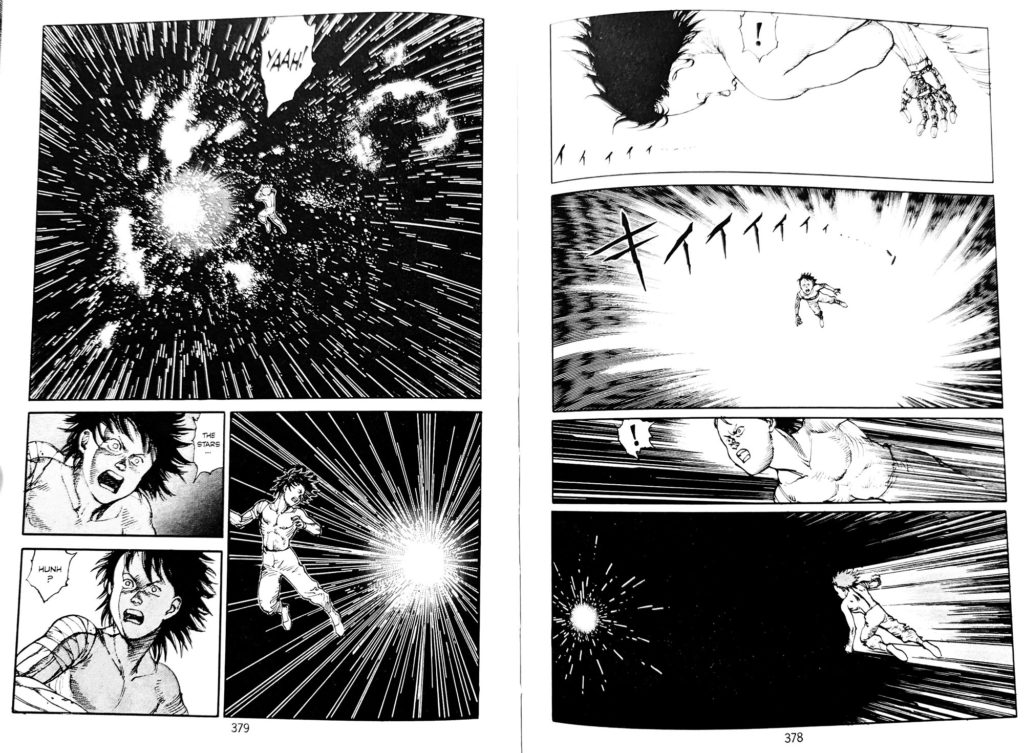
37:50 AKIRA haunts AKIRA. When these issues were coming out, the production process of the movie, how did they interact? Like, there are a lot of very clear elements of the ‘end’ of the AKIRA movie, which technically happens in volume 3, scattered throughout volume 4. Tetsuo flying up into the sky after the space laser, the fluffy white clouds over the destruction, Tetsuo’s memories of his own birth…
Luckily, the websites http://chronotomo.aaandnn.com/ and https://exploringakira.wordpress.com/ exist to help us put together some answers.
In the simplest terms, the manga didn’t end until 1990, two years after the film was released. But the film didn’t start animating until after the sound effects and dialogue had all been recorded, meaning that the story was locked several years before the 1988 material was published. Maybe locked-down as early as 1986. Since this volume was serialized from 1985-1986, I’d say it’s more-than-likely the film’s story could’ve been developed alongside this material…
Oh, and David loves the Space Laser.
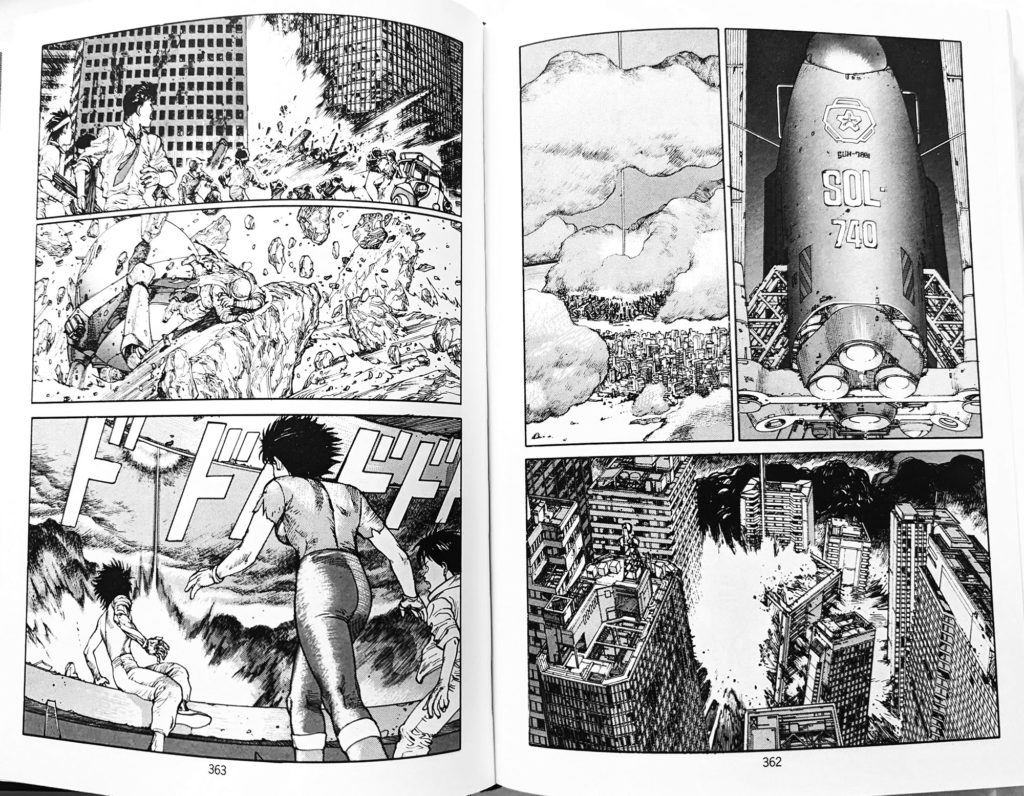
39:50 I believe that author Bryan Lee O’Malley has shared all of this before, but Scott Pilgrim the Movie began to be worked on during the production of volume 2, and I think the film’s story was finalized after volume 3 was completed, with Bryan mapping out the arc of the rest of the series from there. It’s why fan-fav characters like Lisa Miller don’t appear in the movie, and why the Twins use magic rather than robots, for two prominent examples. But like AKIRA, the final showdown of both the film and comic is pretty similar…
40:41 David’s favorite running gag, which was also in the movie, on Page 308, the smoke bomb actually explodes after being called a dud or ‘just a smoke bomb’. It’s actually really subtle, I totally missed it on the first read through, I’m glad David pointed it out!
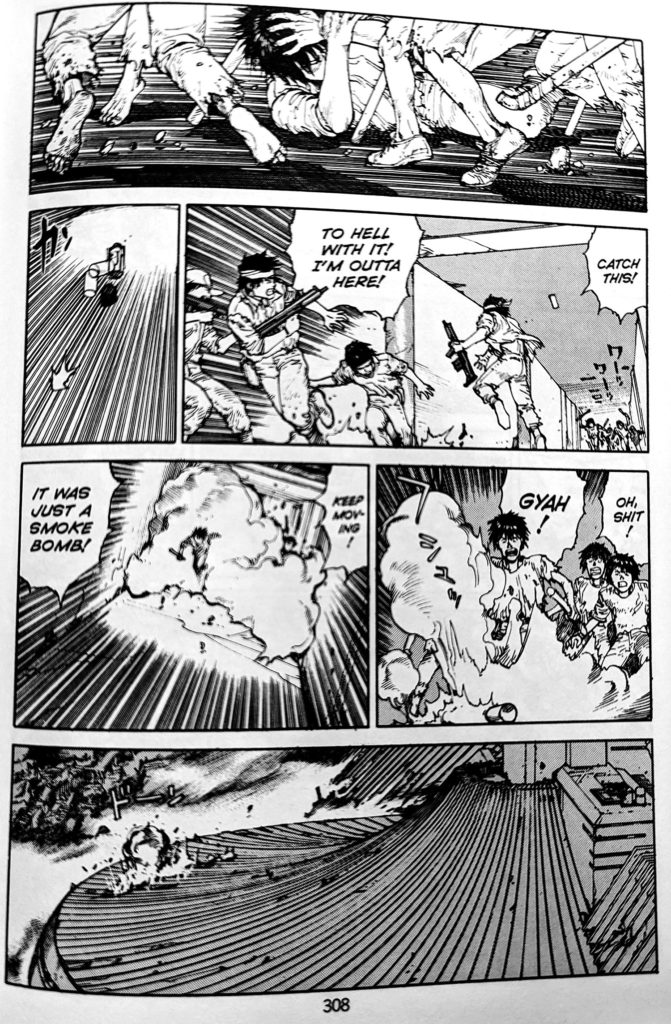
42:00 As David mentions, Lady Miyako’s firm anti-violence stance is so fascinating in the context of this hyper-violent series.
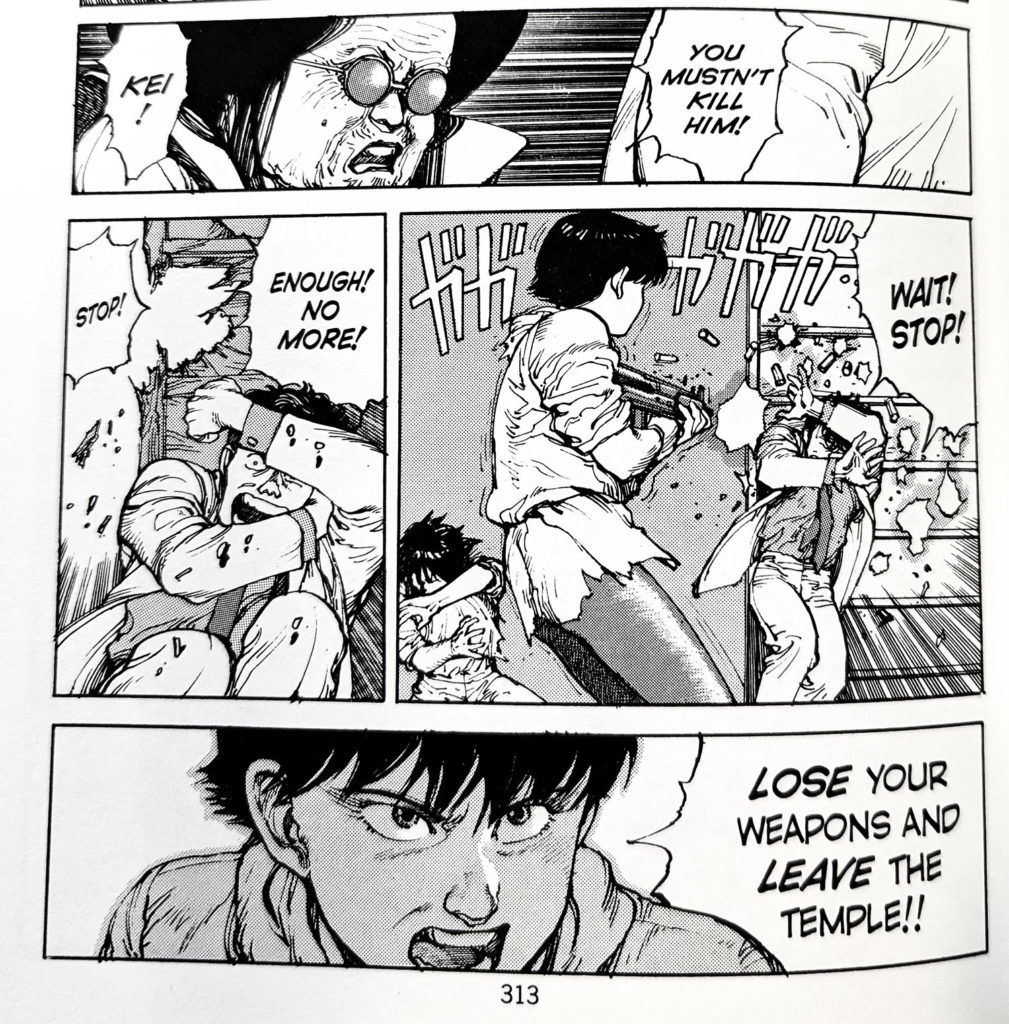
DEB: Although it makes sense if you see her as a combination shaman / priestess, since non-violence is a key tenet of Buddhism / Shinto practices…
43:30 I think I had an idea here I shoulda dug into more, about the value of this volume. This volume really just… wraps up every dangling mystery of the first three volumes, and transitions every character into their positions for the endgame. In fact, taking Kaneda off the board for a volume is probably the only way to do that, because he’s such a big force in the book. Kaneda going into the pocket dimension for a little bit let us focus on just how great the ladies are, and what they’re able to accomplish. It’s a turning point for the series.
47:52 To that point, Otomo is seemingly deeply unconcerned with the ‘mystery’ of AKIRA as a creator. Lady Miyako just like, explains everything when either Kei or Tetsuo asks her. For folks who’ve only seen the films, where the mysteries are SUCH a big deal, this volume must have been completely shocking.
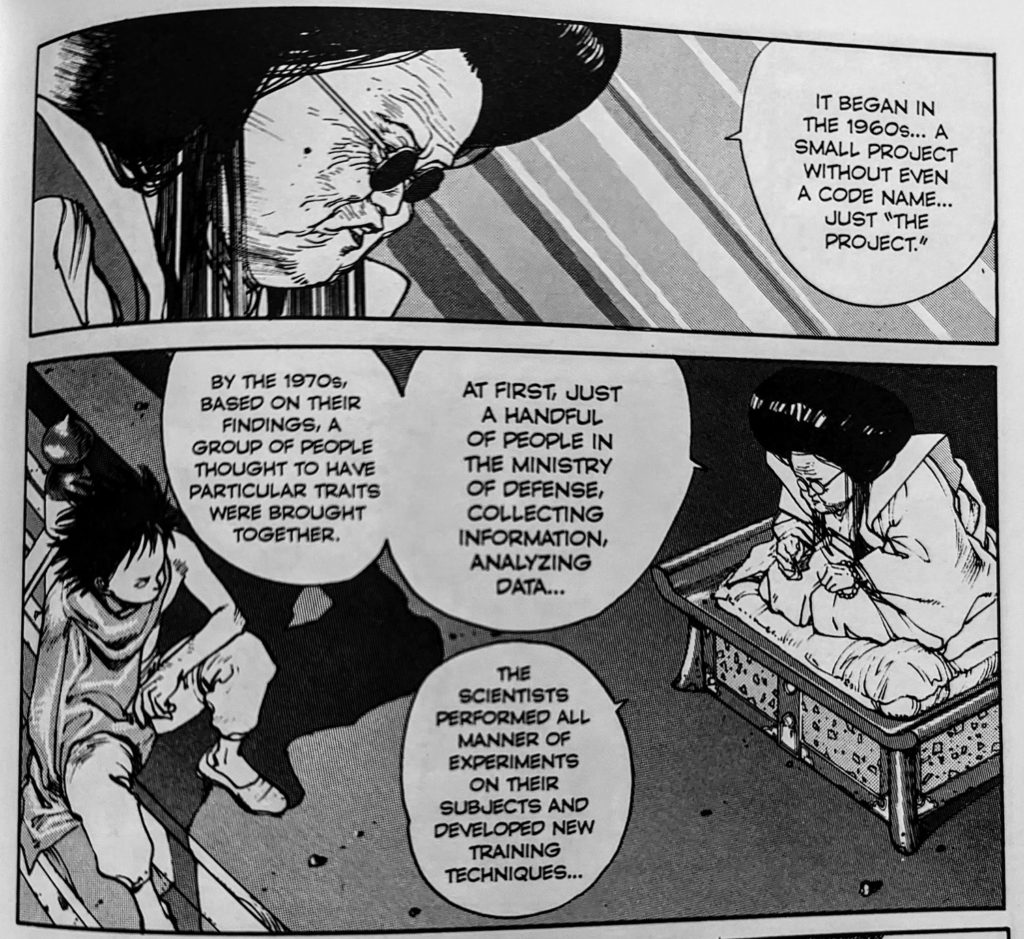
51:55 Kei on page 172, and another fantastic ‘joke’. 😉
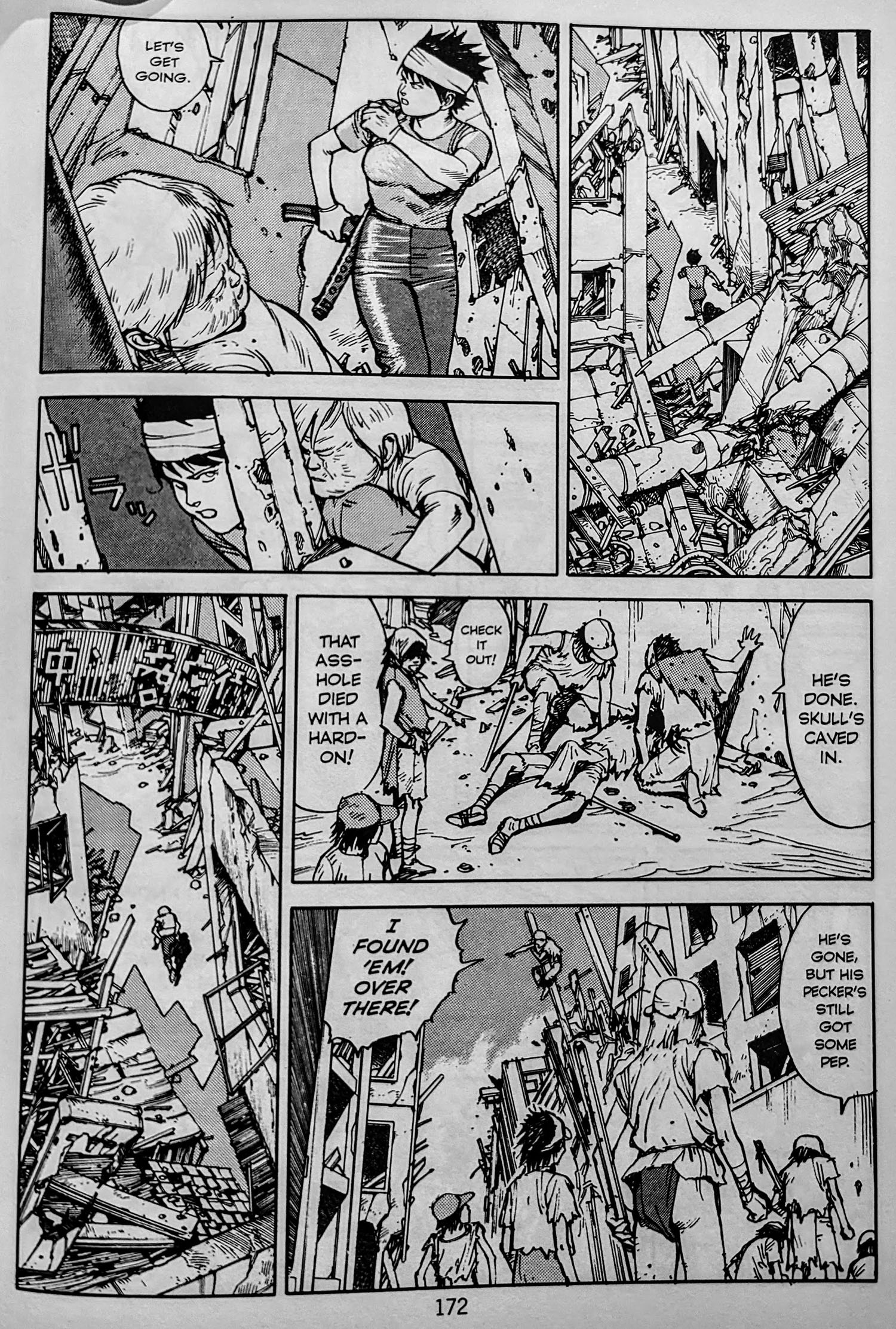
53:15 David got derailed on page 34 because some of the Japanese characters were backwards, and he couldn’t quite figure out what had or hadn’t been ‘flipped’ because of all of the different versions of the manga he’d read. But as Deb points out, those are the backs of translucent hanging signs, and there are Japanese characters in their native orientation on that page too.
But that said, that whole sequence is really interesting for its use of Japanese characters, and leaving them in the translated editions of the book. I mean, they’d be a pain to translate, so many little words, but still, it adds a LOT of character to these few pages, in a volume that is mostly otherwise just rubble.
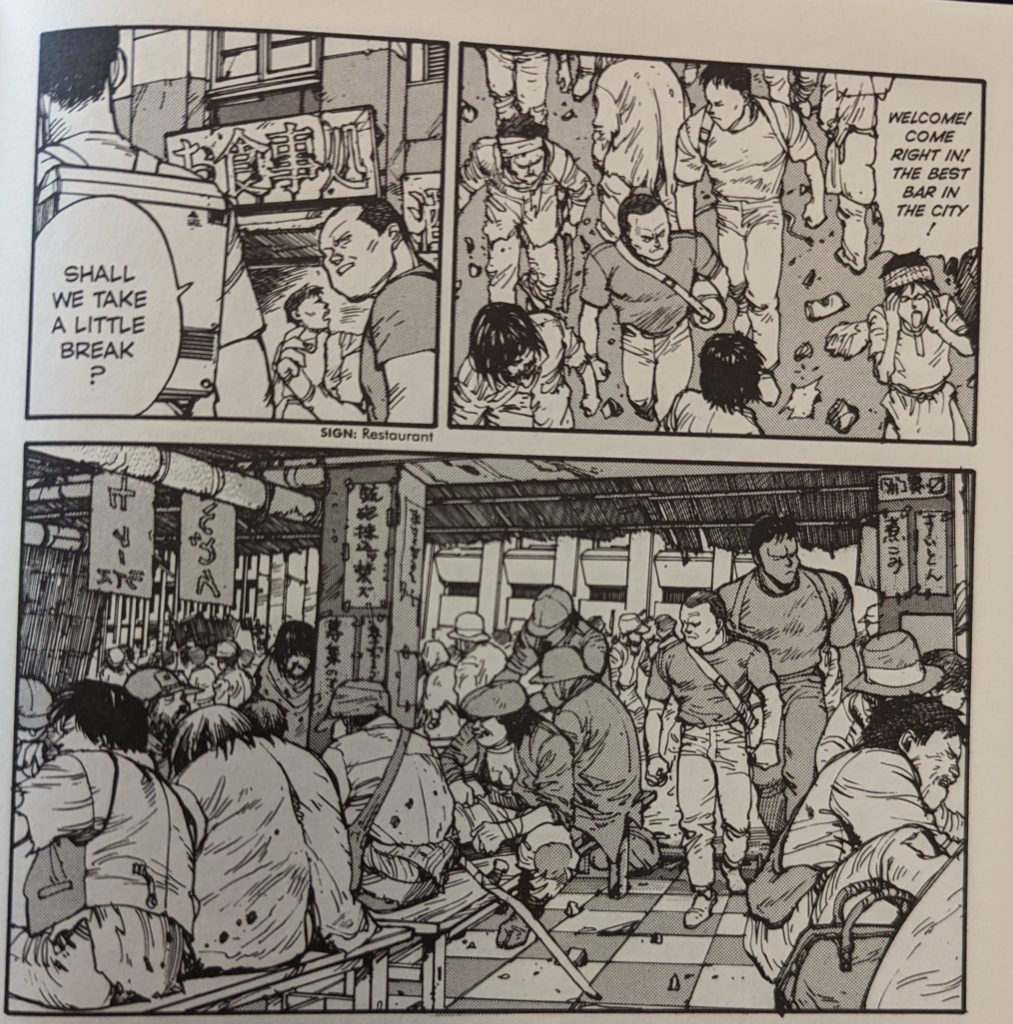
54:30 We are all waiting VERY PATIENTLY for the English editions of the currently-shipping Complete Otomo Library, which to date only exists in Japanese. Deb and I were both here in Japan, and it’s taking all of my willpower not to buy all of these and I think Deb caved and bought a couple… But as David mentions, the exchange rate REALLY is quite good.
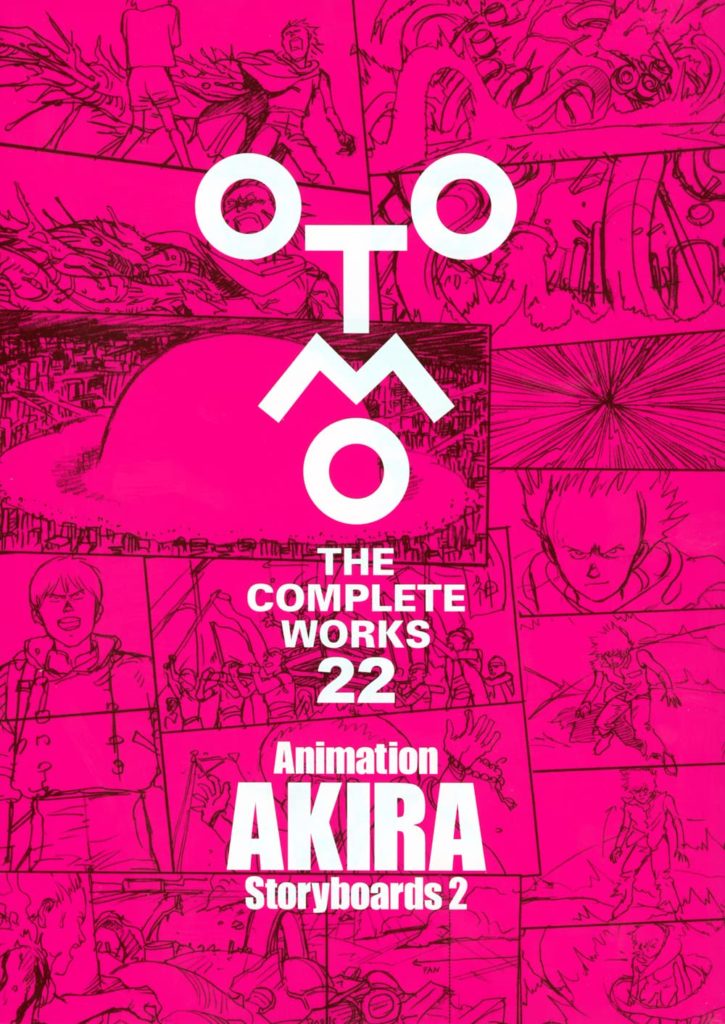
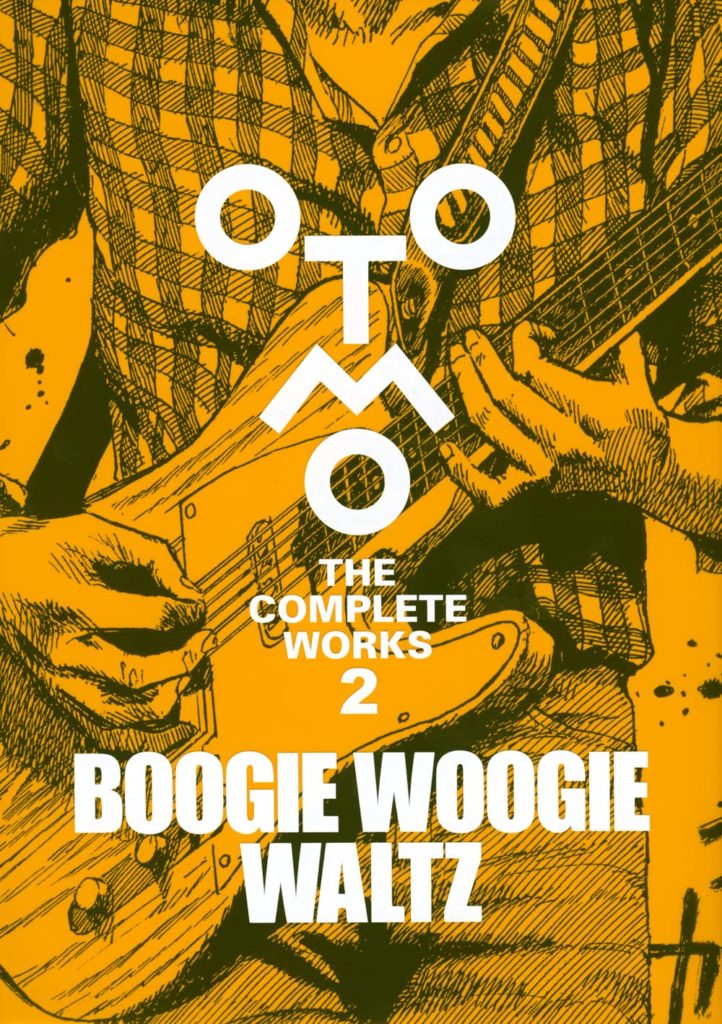
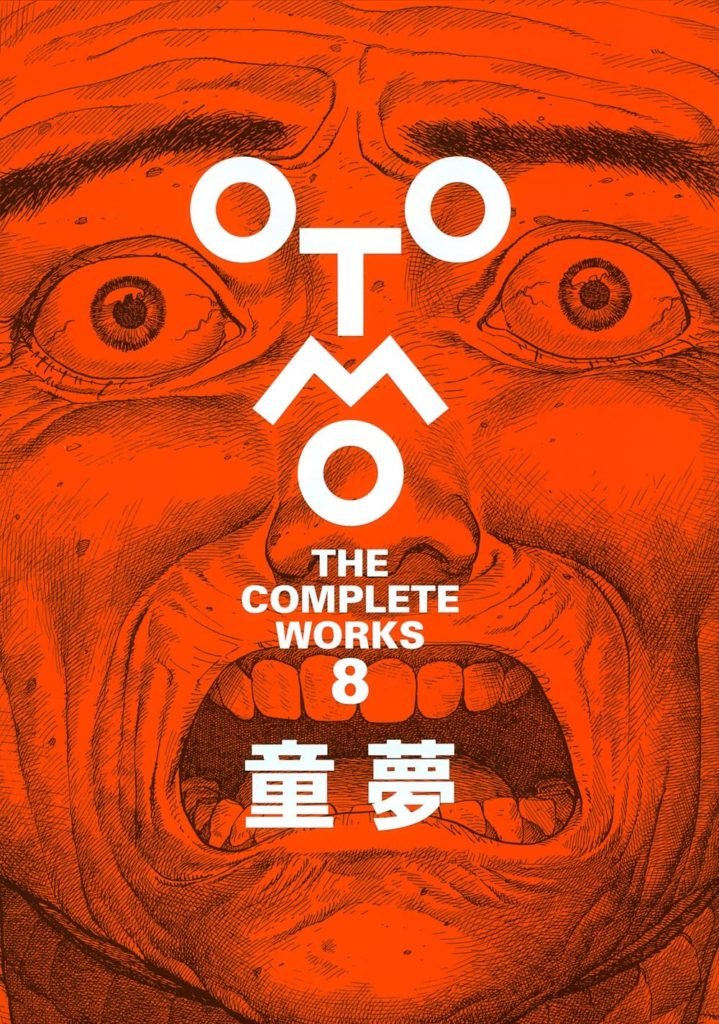
55:30 Yeah, we all did a bit of a double-take on the dude in these pages. According to David, he is black in the color edition, but in the black and white he just kinda reads like a Japanese dude who’s really into Rastafarian culture?
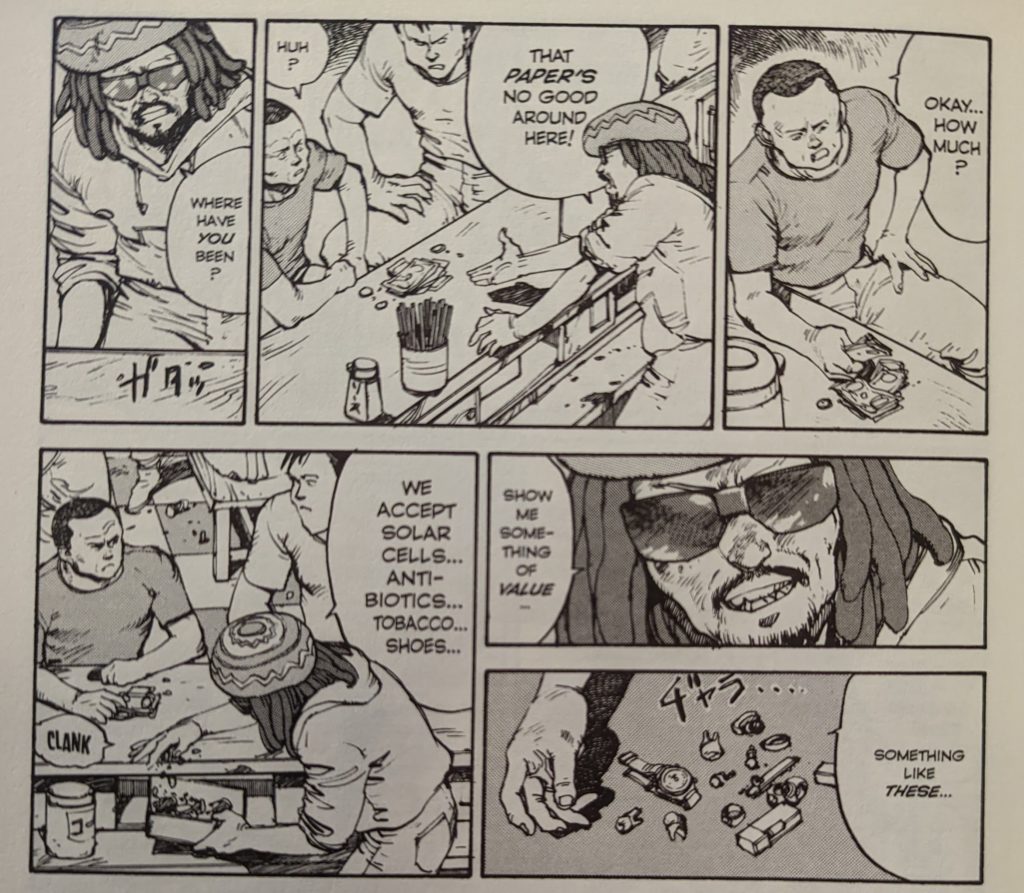
And on that note, we end our discussion of AKIRA Volume 4. What did you think? Sound off in the comments, and then come back quick for a Q&A session!
56:20 THE BREAK
58:00 Welcome back to our somewhat infrequent Q&A section on Mangasplaining! Let’s wrap up this episode with two pretty great questions! First up, David Bednar on Twitter asks:
“Hey @mangasplaining, in America, tie-in media to movies and games and stuff often is held as lower-tier work. Is it the same in Japan? What are tie-in comics that shake the stigma? Something about Cracker Barrel selling the Nightmare Before Christmas manga made me wonder…”
David Bednar
While part of me wants to Mangasplain what “Cracker Barrel” is to our non-American listeners, let’s jump right into the answer!
Basically, David sums it up early (and then we give a whole bunch of other examples), but if it’s approached with care and quality, it isn’t considered lesser at all. But there are absolutely a lot of “jobs” out there to take to get work done. I see it more in the light-novel adaptation space, something’s really popular and you gotta make a few bucks by doing a comic adaptation, but some of those light novel adaptations get top notch illustrators too.
If you wanna find that Adidas Manga, google “アディダスマンガフィーバー” … Mandarake might have copies. 🙂
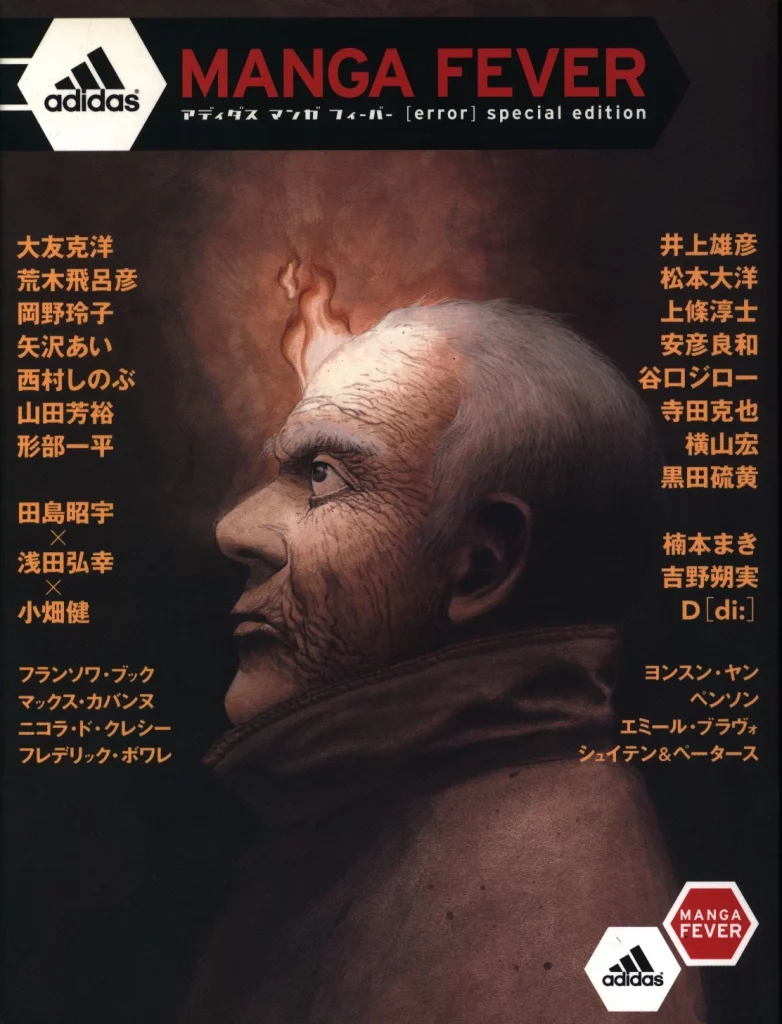
I love that Chip wrote down ‘Batman’ 3 times for the licensed book he most wanted to write at Marvel, and then a few years later both he and former Marvel EiC Joe Quesada are working on Batman. It’s a sublime Chip moment.
We mention all kinds of easily Google-able stuff in this segment, but the revelation that David wrote Gundam fan-fiction… AND YOU CAN GO READ IT… Is pretty good.
I mention the Transformers comics that I helped acquire and that David edited for VIZ Media. All three volumes are currently available in hardcover, you can go grab them now.
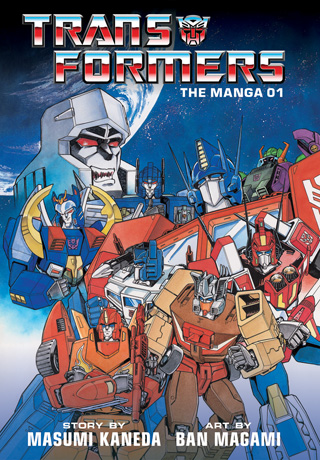
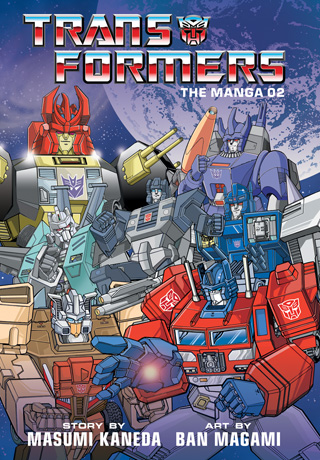
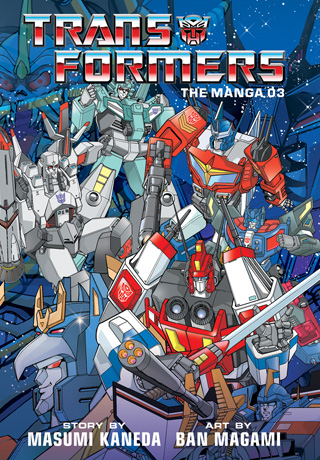
The book I mentioned, Put The Book Back On The Shelf, perhaps the worst possible title of all time (but a pretty fun little Anthology of stories inspired by the band Belle & Sebastian), was published by Image and is now OOP I think. It was specifically panned by Douglas WOLK, not Rushkoff. I wrote about the book at my old blog, and though the directory of comic pages doesn’t work anymore (not sure why!) you can see some of the art and the script.
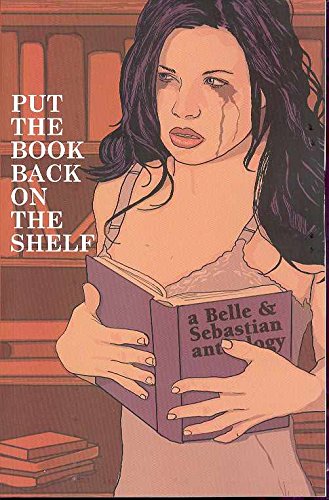
Deb mentions, again, that she is pissed about the ending of Boys Over Flowers aka Hana Yori Dango, the romance manga series by Yoko Kamio that has the tamest possible ending. She also brings up Hot Gimmick, which has a terrible ending, and a novel that acts as an alternate ending that is slightly better, as things she might wanna have a do-over on.
DEB: My bitterness over reading Boys Over Flowers for years and only getting THAT ending will probably linger forever.
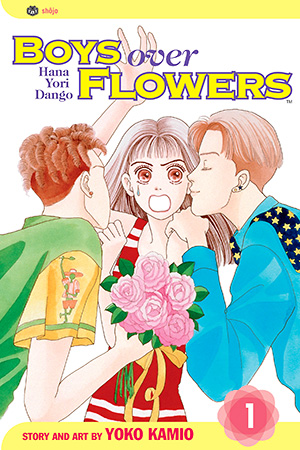
Finally, we mention the doujinshi Doraemon ending that we’ve mentioned before. You can read a sort of weirdly terse article on it on Anime News Network: https://www.animenewsnetwork.com/news/2007-05-29/false-doraemon-ending
Deb also found the Doujinshi online and it’s illegally scanlated but also really interesting, probably worth checking out.
Also, a Kosaku Shima-style comic that is actually him as either Bruce Wayne or Tony Stark running a giant superhero business is one of the best ideas of the season. Whomever gets to Kodansha first wins!
I should note, I love James Tyinon IV, I just like making little jokes about people who have numbers in their names.
Then we come to Question #2, from Erica Friedman! Erica writes in the comment section:
“I have a question for specifically, Chip. He’s read a bunch of manga now, of all kinds. Let’s say one of his buddies asks him for a recommendation to read a manga – which one of the manga that he’s read so far would he choose and why? Chip, you can choose the buddy and the circumstances to frame the choice.
It’s been to fun to see your interest in manga gel. Thanks for going into all this manga so openly!
I mentioned this to Deb when I saw her last week – but this podcast has been critical for my mental well-being. You’ve made me read stuff I would not have, and talked about stuff I’ll never read, which is fantastic and occasionally given some love to books I have enjoyed. Thank you all.”
Erica Friedman
Which is like, so kind and nice. Thank you, Erica!
So Chip’s first manga recommendation was all the way back in Episode 8 with Way of the Househusband to Matt Fraction. Subsequently he has recommended Ping Pong and Vinland Saga to Ryan Stegman, and then Tokyo Tarareba Girls to a ton of different creators. And for his friend Kelly Sue Deconnick, he makes a special recommendation of A Bride’s Story by Kaoru Mori.
These are all manga we’ve covered on the podcast, by the by! Click above for full book info and to listen.
And that’s this week in Mangasplaining! This episode is also available wherever you get your podcasts, so please subscribe and leave a review, so others can discover our show.
Also, if you’d like to get the latest episode delivered straight to your inbox along with exclusive interviews, articles and new chapters of manga you can’t read anywhere else, subscribe to our Substack newsletter. See what you’re missing at Mangasplaining Extra!
Next week, we’ll be doing a season-in-review episode, with some very special picks and a fun discussion.
Thanks so much for listening! Please support your local comic and manga specialty shop when purchasing these books, and you can find one near you at comicshoplocator.com. You can also check your local library for print and digital lending options, they have TONS of manga! Finally, thanks to D.A.D.S. for their musical accompaniment for this episode.
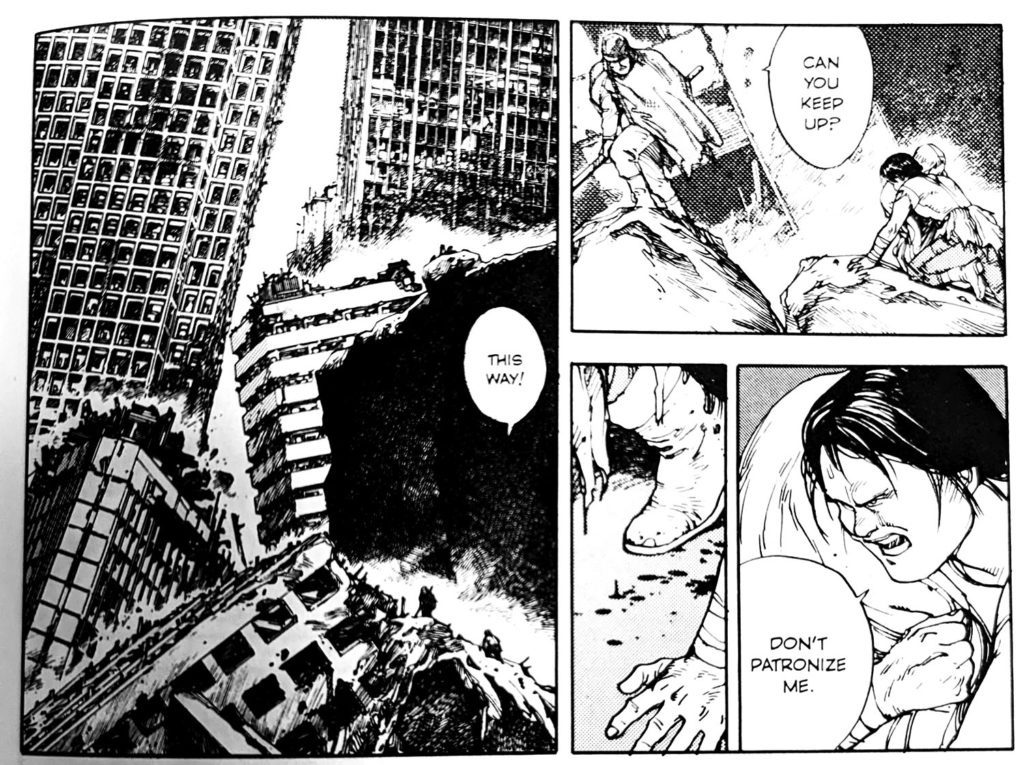
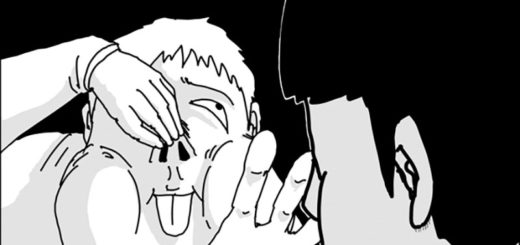
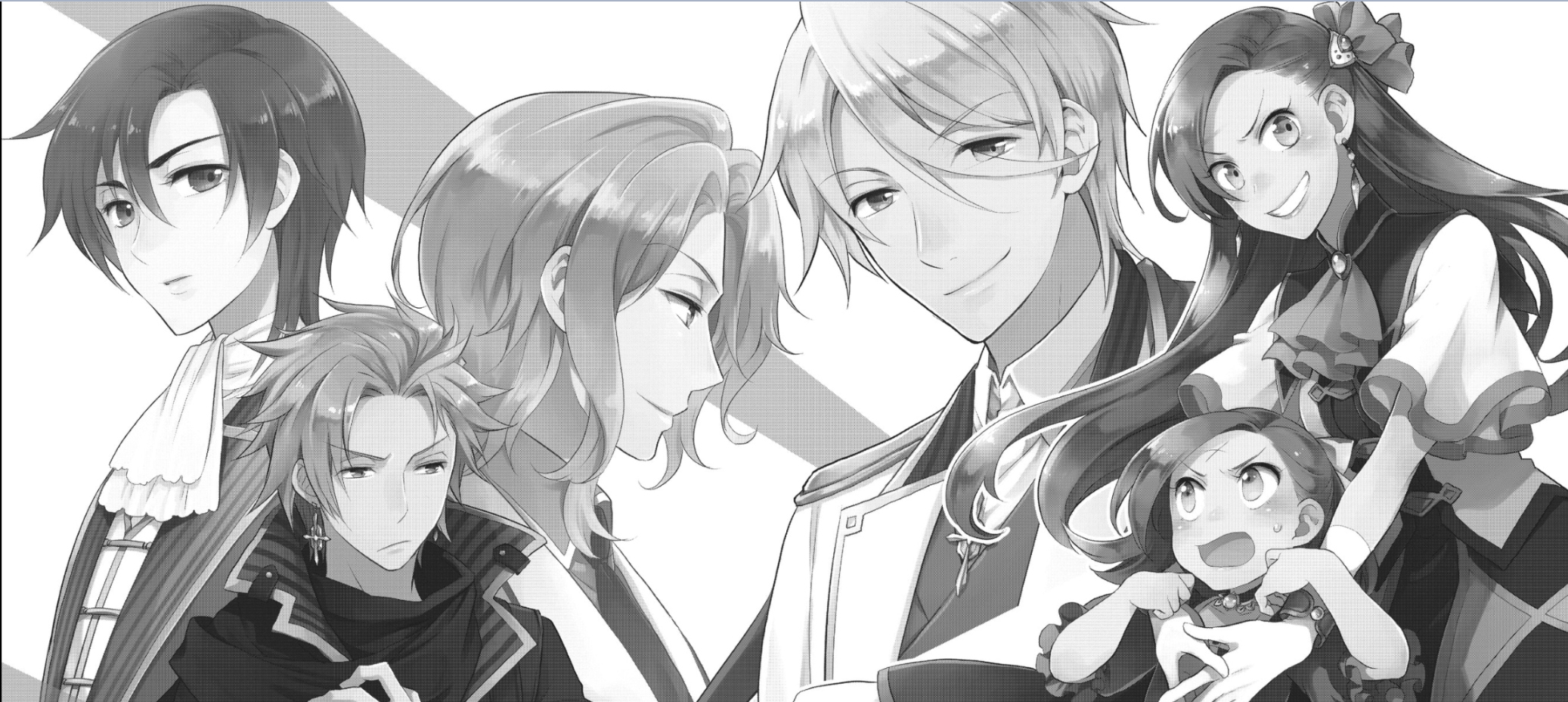
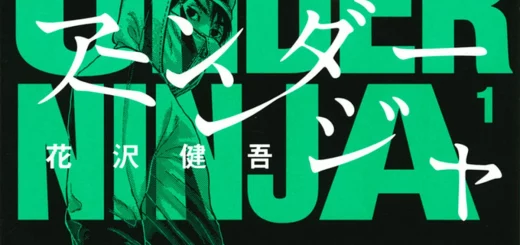
I am not an Akira fan (which I know, I know, would not surprise anyone who knows my manga tastes) but I found this conversation fascinating, especially about the movie. (I had no idea it was a rare anime with the dialogue recorded first…) It’s just a world I don’t want to be in.
Also, I’m now having flashbacks to my teenage obsession with Belle and Sebastian (but no shout out to the anime where they got their name from? I watched it here in Canada as a kid in French.) I’ll have to track down Chris’ story.
Thanks to all four of you for another terrific season of the best manga podcast.
Extremely late to this one, but the Akira episodes are always great to listen to. On the subject of tie-in manga I found a really fun and obscure one a few months ago at a local used book store – https://twitter.com/pi8you/status/1586486409665429505
It turns out that way back in 1996, the X-Files got a 3-volume run adapting half a dozen episodes from the first season, under the pencils of a handful of creators that worked in a few different genres. The first volume went seinen with artists Syufo Itahashi and Kazumi Kakizaki, while the second (which was the one I found) was a shoujo affair drawn by Sen Inoue and Yasuko Sakata (who seems to have made a very, uh, particular contribution to the manga lexicon back in the day https://en.wikipedia.org/wiki/Yasuko_Sakata), before closing things out with Wild 7’s Mikiya Mochizuki adapting both episodes in the third volume.
So, if you want to know how the chronology of Volume 4 serialisation and the making of the movie, you will find your answer in Akira Club. The art book contains the messages that Otomo would write to the readers in Young Magazine at the beginning of every chapter. At a certain point, there is one where it says something like ‘I will take a pause of a month to make the movie’…but then the following chapter/message is dated 1 year and half after. So, basically somewhere in the middle of Volume 4 there is a 1+ yer long hiatus.